#Meliodosi
Text
GUERRA BIOLOGICA: MADE IN AMERICA?
Fonte: Center For An Informed America
Di Dave McGowan6 ottobre 2001
Nonostante i migliori sforzi dei funzionari statunitensi nel proiettare la nazione del Pakistan a fedele alleato nella “guerra orwelliana al terrorismo”, la verità è che solo un piccolo gruppo di leader illegittimi di quella nazione hanno promesso il loro sostegno verso gli obiettivi militari americani. La stragrande…

View On WordPress
#Antrace#Bill Clinton#Brucellosi#CCHF#Dave McGowan#Deep State#Ebola#Febbre emorragica#Flea bomb#George W. Bush#Guerra Batteriologica#Guerra Biologica#Meliodosi#Morva#OMS#Osama bin Laden#Peste#Pingfan#Psittacosi#Rickettsiosi#Russia#Terrorismo#Tularemia#USA#Virus#WWII
0 notes
Text
#bioterrorist attacks:#anthrax #variola #glanders #meliodosis
withheld info on #OhioChernobil train derailment(vinyl chloride, phosgene, hydrogen chloride,CO2,HCI,dioxins)..
media diverted by #balloon?
"#war is young men dying and men talking''#Roosevelt
https://salvatoremercogliano.blogspot.com/2023/02/emergency-for-you-not-for-me.html?spref=tw

1 note
·
View note
Photo

https://www.dailymail.co.uk/health/article-11055573/Deadly-bacteria-causes-meliodosis-detected-Mississippi-water-CDC-reveals.html
1 note
·
View note
Text
Las armas biológicas del pentágono
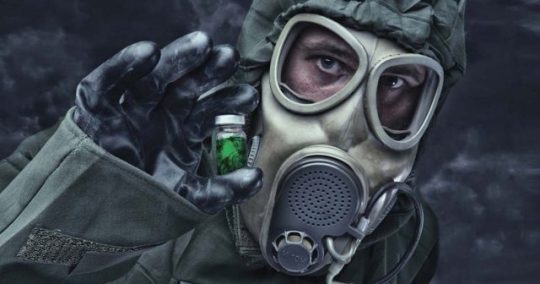
Nota de terraindomita: Dado que incluso se está dudando de la propia existencia de los virus y, aun admitiendola, solamente son paquetes de información genética envueltos en una proteína y son incapaces de infectar (nuestro cuerpo recibe solamente esa información de otros seres humanos, pues los “virus” naturales no saltan entre especies, y reacciona ante ella), recomendamos la lectura entrecomillada del término “virus” cuando aparezca en el siguiente artículo, de abril de 2018, de la investigadora búlgara Dilyana Gaytandzhieva.
El ejército estadounidense produce regularmente virus, bacterias y toxinas mortales, violando directamente la Convención de la ONU sobre la prohibición de las armas biológicas. Cientos de miles de personas involuntarias son expuestas sistemáticamente a peligrosos patógenos y otras enfermedades incurables. Los científicos de la guerra biológica, utilizando una tapadera diplomática, prueban virus artificiales en los laboratorios biológicos del Pentágono en 25 países de todo el mundo. Estos laboratorios biológicos estadounidenses están financiados por la Agencia de Reducción de la Amenaza de Defensa (DTRA) en el marco de un programa militar de 2.100 millones de dólares, el Programa de Compromiso Biológico Cooperativo (CBEP), y están situados en países de la antigua Unión Soviética, como Georgia y Ucrania, en Oriente Medio, en el Sudeste Asiático y en África
El Lugar Center es el laboratorio biológico del Pentágono en Georgia. Está situado a sólo 17 km de la base aérea militar estadounidense de Vaziani, en la capital, Tiflis. Los encargados del programa militar son biólogos de la US Army Medical Research Unit-Georgia (USAMRU-G) junto con contratistas privados. Al laboratorio de nivel 3 de bioseguridad sólo pueden acceder ciudadanos estadounidenses con autorización de seguridad. Se les concede inmunidad diplomática en virtud del Acuerdo de 2002 entre Estados Unidos y Georgia sobre cooperación en materia de defensa.
La información obtenida del registro de contratos federales de EE.UU. aclara algunas de las actividades militares del Lugar Center, entre ellas lainvestigación sobre agentes biológicos (ántrax, tularemia) y enfermedades víricas (por ejemplo, la fiebre hemorrágica de Crimea-Congo), y la recogida de muestras biológicas para futuros experimentos.
Los contratistas del Pentágono producen agentes biológicos bajo cobertura diplomática
La Agencia de Reducción de la Amenaza de Defensa (DTRA) ha subcontratado gran parte del trabajo del programa militar a empresas privadas, que no tienen que rendir cuentas al Congreso, y que pueden operar con mayor libertad y sortear el imperio de la ley. El personal civil estadounidense que realiza trabajos en el Lugar Center también ha recibido inmunidad diplomática, aunque no son diplomáticos. Por tanto, las empresas privadas pueden realizar trabajos, bajo cobertura diplomática, para el gobierno estadounidense sin estar bajo el control directo del Estado anfitrión, en este caso la República de Georgia. Esta práctica es utilizada a menudo por la CIA para dar cobertura a sus agentes. En el laboratorio biológico estadounidense de Tiflis trabajan tres empresas privadas estadounidenses: CH2M Hill, Battelle y Metabiota. Además del Pentágono, estos contratistas privados realizan investigaciones para la CIA y otras agencias gubernamentales.
CH2M Hill ha recibido 341,5 millones de dólares de contratos de la DTRA en el marco del programa del Pentágono para laboratorios biológicos en Georgia, Uganda, Tanzania, Irak, Afganistán y el Sudeste Asiático. La mitad de esta suma (161,1 millones de dólares), se ha asignado a The Lugar Center, en el marco del contrato de Georgia. Según CH2M Hill, la empresa estadounidense ha conseguido agentes biológicos y ha contratado a antiguos científicos de guerra biológica en el Lugar Center. Se trata de científicos que trabajan para otra empresa estadounidense implicada en el programa militar de Georgia: el Battelle Memorial Institute.
Battelle, como subcontratista del Lugar Center por valor de 59 millones de dólares, tiene una amplia experiencia en la investigación de agentes biológicos, ya que la empresa ya ha trabajado en el Programa de Armas Biológicas de los Estados Unidos en virtud de 11 contratos previos con el Ejército de los Estados Unidos (1952-1966).
La empresa privada realiza trabajos para los laboratorios biológicos de la DTRA del Pentágono en Afganistán, Armenia, Georgia, Uganda, Tanzania, Irak y Vietnam. Battelle lleva a cabo la investigación, el desarrollo, las pruebas y la evaluación con productos químicos altamente tóxicos y agentes biológicos altamente patógenos para una amplia gama de agencias gubernamentales estadounidenses. Ha recibido unos 2.000 millones de dólares de contratos federales en total y ocupa el puesto 23 en la lista de los 100 principales contratistas del gobierno estadounidense.
El Proyecto Clear Vision de la CIA y Battelle
El Proyecto Clear Vision (1997 y 2000), una investigación conjunta de la CIA y el Battelle Memorial Institute, en virtud de un contrato adjudicado por la Agencia, reconstruyó y probó una bomba de ántrax de la era soviética para comprobar sus características de diseminación. El objetivo declarado del proyecto era evaluar las características de diseminación de los bioagentes de las bombas. La operación clandestina de la CIA-Battelle se omitió en las declaraciones de la Convención sobre Armas Biológicas de Estados Unidos presentadas a la ONU.
Experimentos de alto secreto
Battelle ha operado un laboratorio biológico de alto secreto (National Biodefense Analysis and Countermeasures Center – NBACC) en Fort Detrick, Maryland, bajo un contrato del Departamento de Seguridad Nacional (DHS) de los Estados Unidos durante la última década. La empresa ha recibido un contrato federal de 344,4 millones de dólares (2006 – 2016) y otro de 17,3 millones (2015 -2026) del DHS.
Entre los experimentos secretos, realizados por Battelle en el NBACC, se encuentran: Evaluación de la tecnología de diseminación del polvo; Evaluación del peligro que suponen las toxinas en aerosol y Evaluación de la virulencia de B. Pseudomallei (Meliodosis) en función de la partícula de aerosol en primates no humanos. La melioidosis tiene el potencial de desarrollarse como arma biológica, por lo que se clasifica como agente de bioterrorismo de categoría B. B. Pseudomallei fue estudiado por los Estados Unidos como una potencial arma biológica en el pasado.
Además de los experimentos militares en el Lugar Center de Georgia, Battelle ya ha producido agentes bioterroristas en el Laboratorio de Alto Secreto de Nivel de Bioseguridad 4 del NBACC en Fort Detrick, en Estados Unidos. Una presentación del NBACC enumera 16 prioridades de investigación para el laboratorio. Entre ellas, caracterizar los patógenos clásicos, emergentes y de ingeniería genética por su potencial de BTA (agente de amenaza biológica); evaluar la naturaleza de la inducción no tradicional, novedosa y no endémica de la enfermedad a partir de potenciales BTA y ampliar la capacidad de pruebas de desafío de aerosoles para primates no humanos.
La empresa estadounidense Metabiota Inc. ha obtenido contratos federales por valor de 18,4 millones de dólares en el marco del programa DTRA del Pentágono en Georgia y Ucrania para la prestación de servicios de consultoría científica y técnica. Los servicios de Metabiota incluyen la investigación global de amenazas biológicas sobre el terreno, el descubrimiento de patógenos, la respuesta a brotes y los ensayos clínicos. Metabiota Inc. había sido contratada por el Pentágono para realizar trabajos para DTRA antes y durante la crisis del ébola en África Occidental y se le concedieron 3,1 millones de dólares (2012-2015) para trabajar en Sierra Leona, uno de los países en el epicentro del brote de ébola.
Un informe del 17 de julio de 2014, redactado por el Consorcio de la Fiebre Hemorrágica Viral, acusó a Metabiota Inc. de no respetar un acuerdo existente sobre cómo informar de los resultados de las pruebas y de pasar por alto a los científicos de Sierra Leona que trabajaban allí. El informe también planteaba la posibilidad de que Metabiota estuviera cultivando células sanguíneas en el laboratorio, algo que, según el informe, era peligroso, además de diagnosticar erróneamente a pacientes sanos. Metabiota negó todas estas acusaciones.
Experimentos militares con insectos que pican
La guerra entomológica es un tipo de guerra biológica que utiliza insectos para transmitir enfermedades. El Pentágono ha realizado supuestamente este tipo de pruebas entomológicas en Georgia y Rusia. En 2014, el Centro Lugar se dotó de una instalación para insectos y puso en marcha el proyecto “Concienciación sobre el código de barras de las moscas de la arena en Georgia y el Cáucaso”. El proyecto abarcó una zona geográfica más amplia fuera de Georgia – Cáucaso. En 2014-2015 se recogieron especies de moscas de la arena flebótomos en el marco de otro proyecto “Trabajo de vigilancia de las enfermedades febriles agudas” y se analizaron todas las moscas de la arena (hembras) para determinar su tasa de infectividad. En un tercer proyecto, que también incluía la recogida de flebótomos, se estudiaron las características de sus glándulas salivales.
Como resultado, Tiflis está infestada de moscas picadoras desde 2015. Estos insectos picadores viven en el interior, en los baños, durante todo el año, lo que no era el comportamiento típico de estas especies en Georgia anteriormente (normalmente la temporada de la mosca flebotomina en Georgia es excepcionalmente corta: de junio a septiembre). Los habitantes de la zona se quejan de haber sido picados por estas moscas recién aparecidas mientras estaban desnudos en sus baños. Además, tienen una gran resistencia al frío y pueden sobrevivir incluso en las temperaturas bajo cero de las montañas.
Moscas que pican en Daguestán (Rusia)
Desde el inicio del proyecto del Pentágono en 2014 han aparecido en la vecina Daguestán (Rusia) moscas similares a las de Georgia. Según la población local, pican y provocan erupciones. Su hábitat de cría son los desagües de las casas.
Las moscas de la familia de los flebótomos son portadoras de peligrosos parásitos en su saliva que transmiten a través de una picadura a los seres humanos. La enfermedad que transmiten estas moscas es de gran interés para el Pentágono. En 2003, durante la invasión de Irak, los soldados estadounidenses sufrieron graves picaduras de moscas de la arena y contrajeron leishmoniasis. La enfermedad es originaria de Irak y Afganistán y, si no se trata, la forma aguda de la leishmoniasis puede ser mortal.
Un informe del ejército estadounidense de 1967 “Arthropods of medical importance in Asia and the European USSR” (Artrópodos de importancia médica en Asia y la URSS europea) enumera todos los insectos locales, su distribución y las enfermedades que transmiten. Las moscas mordedoras, que viven en los desagües, también figuran en el documento. Sin embargo, su hábitat natural es Filipinas, no Georgia ni Rusia.
Operación Whitecoat: Se prueba que las moscas infectadas pican a los humanos
En 1970 y 1972, se realizaron pruebas de la fiebre de la mosca de la arena en seres humanos, según un informe desclasificado del ejército estadounidense – US Army Activities in the US, Biological Warfare Programs, 1977, vol. II, p. 203. Durante la operación Whitecoat se expuso a voluntarios a las picaduras de moscas de la arena infectadas. La operación Whitecoat fue un programa de investigación médica de biodefensa llevado a cabo por el ejército estadounidense en Fort Detrick, Maryland, entre 1954 y 1973.
A pesar de la finalización oficial del programa de armas biológicas de Estados Unidos, en 1982 el USAMRIID realizó un experimento sobre si las moscas de la arena y los mosquitos podían ser vectores del virus del Valle del Rift, el dengue, la chikungunya y la encefalitis equina oriental, virus que el ejército estadounidense investigaba por su potencial como armas biológicas.
Insectos asesinos
El Pentágono tiene un largo historial en el uso de insectos como vectores de enfermedades. Según un informe parcialmente desclasificado del Ejército de EE.UU. de 1981, los científicos estadounidenses de guerra biológica llevaron a cabo una serie de experimentos con insectos. Estas operaciones formaban parte de la Guerra Entomológica de EE.UU. bajo el Programa de Armas Biológicas de EE.UU.
El Pentágono: Cómo matar a 625.000 personas por sólo 0,29 dólares de coste por muerte
Un informe del ejército estadounidense de 1981 comparó dos escenarios: 16 ataques simultáneos a una ciudad por parte de los mosquitos A. Aegupti, infectados con la fiebre amarilla, y el ataque con aerosol de la tularemia, y evalúa su eficacia en cuanto a coste y número de víctimas.
Operación “Big Itch”: Se realizaron pruebas de campo para determinar los patrones de cobertura y la capacidad de supervivencia de la pulga de rata tropical Xenopsylla cheopis para su uso como vector de enfermedades en la guerra biológica.
Operación Big Buzz: Se produjeron 1 millón de mosquitos A. Aeugupti, 1/3 se colocaron en municiones y se lanzaron desde aviones, o se dispersaron por el suelo. Los mosquitos sobrevivieron al lanzamiento aéreo y buscaron activamente la sangre humana.
Operación May Day: Los mosquitos Aedes Aegupti fueron dispersados mediante métodos terrestres en Georgia, Estados Unidos, durante una operación del ejército estadounidense denominada May Day.
Algunas partes del informe del ejército estadounidense de 1981, como la “Producción masiva de Aedes Aegypti”, no han sido desclasificadas, lo que podría significar que el proyecto sigue en marcha.
El Aedes Aegypti, también conocido como mosquito de la fiebre amarilla, ha sido ampliamente utilizado en las operaciones militares estadounidenses. La misma especie de mosquitos es supuestamente el vector del dengue, el chikungunya y el virus del Zika, que provoca malformaciones genéticas en los recién nacidos.
Operación Bellweather
El Mando de Investigación y Desarrollo Químico del Ejército de EE.UU., Sección de Armas Biológicas, estudió la actividad de las picaduras de mosquitos al aire libre en una serie de pruebas de campo en el Campo de Pruebas de Dugway, Utah, en 1960. Se probaron hembras vírgenes de mosquitos Aedes aegypti, que habían sido privadas de alimento, sobre las tropas al aire libre.
Experimentos militares con mosquitos y garrapatas tropicales en Georgia
Estas especies de mosquitos y pulgas (estudiadas en el pasado en el marco del Programa de Guerra Entomológica de Estados Unidos) también se han recogido en Georgia y se han sometido a pruebas en el Centro Lugar.
En el marco del proyecto DTRA “Virus y otros arbovirus en Georgia”, en 2014 se detectó por primera vez el mosquito tropical Aedes albopictus, nunca antes visto, y después de décadas (60 años) se confirmó la existencia del mosquito Aedes Aegypti en el oeste de Georgia.
Estos mosquitos tropicales Aedes Albopictus, que nunca se habían visto en Georgia, también se han detectado en la vecina Rusia (Krasnodar) y en Turquía, según los datos facilitados por el Centro Europeo para la Prevención y el Control de las Enfermedades. Su propagación es inusual en esta parte del mundo.
Los mosquitos Aedes Aegupti se han distribuido únicamente en Georgia, el sur de Rusia y el norte de Turquía. Se detectaron por primera vez en 2014 tras el inicio del programa del Pentágono en el Centro Lugar.
En el marco de otro proyecto del DTRA “Epidemiología y ecología de la tularemia en Georgia” (2013-2016) se recogieron 6 148 garrapatas del suelo; 5 871 se recogieron del ganado y se capturaron 1 310 pulgas y 731 garrapatas. En 2016 se recogieron otras 21 590 garrapatas que se estudiaron en el Lugar Center.
Brote de ántrax en Georgia y ensayos en humanos de la OTAN
En 2007 Georgia puso fin a su política de vacunación anual obligatoria contra el carbunco en el ganado. Como resultado, la tasa de morbilidad de la enfermedad alcanzó su punto máximo en 2013. Ese mismo año, la OTAN inició las pruebas de la vacuna contra el ántrax en humanos en el Centro Lugar de Georgia.
Investigación del Pentágono sobre el ántrax ruso
El ántrax es uno de los agentes biológicos convertidos en armas por el ejército estadounidense en el pasado. A pesar de las afirmaciones del Pentágono de que su programa es sólo defensivo, hay hechos que demuestran lo contrario. En 2016, en el Centro Lugar, científicos estadounidenses llevaron a cabo una investigación sobre la “Secuencia del genoma de la cepa de la vacuna soviética/rusa Bacillus anthracis 55-VNIIVViM“, que fue financiada por el Programa de Compromiso Biológico Cooperativo de la Agencia de Reducción de la Amenaza de Defensa de Estados Unidos (DTRA) en Tbilisi, y administrada por Metabiota (el contratista estadounidense bajo el programa del Pentágono en Georgia).
En 2017, la DTRA financió otra investigación: diez secuencias del genoma de aislados humanos y ganaderos de Bacillus anthracis del país de Georgia, que fue realizada por USAMRU-G en el Centro Lugar.
34 personas infectadas por la fiebre hemorrágica de Crimea-Congo en Georgia
La fiebre hemorrágica de Crimea-Congo (FCHC) está causada por la infección a través de un virus transmitido por garrapatas (Nairovirus). La enfermedad se caracterizó por primera vez en Crimea en 1944 y se le dio el nombre de fiebre hemorrágica de Crimea. Posteriormente, en 1969, se reconoció como causa de la enfermedad en el Congo, lo que dio lugar al nombre actual de la enfermedad. En 2014 se infectaron 34 personas (entre ellas un niño de 4 años) con FHCC. 3 de las cuales murieron. Ese mismo año, biólogos del Pentágono estudiaron el virus en Georgia en el marco del proyecto DTRA “Epidemiología de las enfermedades febriles causadas por los virus del dengue [http:/www.ncdc.ge/Category/Article/1480] y otros arbovirus en Georgia”. El proyecto incluía pruebas en pacientes con síntomas de fiebre y la recogida de garrapatas, como posibles vectores del CCHV para su análisis en el laboratorio.
Todavía se desconoce la causa del brote de FHCC en Georgia. Según el informe del Departamento Veterinario local sólo una garrapata de todas las recogidas en los pueblos infectados dio positivo en la enfermedad. A pesar de las afirmaciones de las autoridades locales de que el virus se transmitió a los humanos a partir de los animales, todas las muestras de sangre de los animales también fueron negativas. La ausencia de garrapatas y animales infectados es inexplicable dado el fuerte aumento de casos humanos de FHCC en 2014, lo que significa que el brote no fue natural y el virus se propagó intencionadamente.
En 2016 se recogieron otras 21 590 garrapatas para la base de datos de ADN para futuros estudios en el Centro Lugar en el marco del proyecto del Pentágono “Evaluación de la seroprevalencia y la diversidad genética del virus de la fiebre hemorrágica de Crimea-Congo (CCHFV) y los hantavirus en Georgia”.
También se han notificado 237 casos de fiebre hemorrágica de Crimea-Congo en todo Afganistán, 41 de ellos mortales hasta diciembre de 2017. Según el Ministerio de Salud de Afganistán, la mayoría de los casos se han registrado en la capital, Kabul, donde se han notificado 71 casos con 13 víctimas mortales, y en la provincia de Herat, cerca de la frontera con Irán (67 casos).
Afganistán es uno de los 25 países de todo el mundo que cuentan con laboratorios biológicos del Pentágono en su territorio. El proyecto en Afganistán forma parte del programa de biodefensa estadounidense – Cooperative Biological Engagement Program (CBEP), financiado por la Defense Threat Reduction Agency (DTRA). Los contratistas de la DTRA, que trabajan en el Centro Lugar de Georgia, CH2M Hill y Battelle también han sido contratados para el programa en Afganistán. A CH2M Hill se le ha concedido un contrato de 10,4 millones de dólares (2013-2017). Los contratistas del Pentágono en Afganistán y Georgia son los mismos y también lo son las enfermedades que se propagan entre la población local en ambos países.
Por qué el Pentágono colecciona y estudia murciélagos
Los murciélagos son supuestamente los huéspedes reservorios del virus del Ébola, el síndrome respiratorio de Oriente Medio (MERS) y otras enfermedades mortales. Sin embargo, actualmente se desconocen las formas precisas de transmisión de estos virus a los humanos. Se han realizado numerosos estudios en el marco del Programa de Cooperación Biológica (CBEP) de la DTRA en busca de patógenos mortales de importancia militar en los murciélagos.
Se ha culpado a los murciélagos del mortal brote de ébola en África (2014-2016). Sin embargo, nunca se han aportado pruebas concluyentes de cómo exactamente el virus “saltó” a los humanos, lo que hace sospechar de una infección intencionada y no natural.
La ingeniería de virus mortales es legal en Estados Unidos
Se cree que el MERS-CoV se origina en los murciélagos y se propaga directamente a los humanos y/o a los camellos. Sin embargo, al igual que el Ébola, se desconocen las formas precisas de propagación del virus. Se han registrado 1.980 casos con 699 muertes en 15 países de todo el mundo (hasta junio de 2017) causados por el MERS-CoV.
El MERS-CoV es uno de los virus que han sido diseñados por Estados Unidos y estudiados por el Pentágono, al igual que la gripe y el SARS. La confirmación de esta práctica es la prohibición temporal de Obama en 2014 sobre la financiación del gobierno para este tipo de investigación de “doble uso”. La moratoria se levantó en 2017 y los experimentos han continuado. Los experimentos con patógenos pandémicos potenciales mejorados (PPP) son legales en Estados Unidos. Estos experimentos tienen como objetivo aumentar la transmisibilidad y/o virulencia de los patógenos.
La tularemia como arma biológica
La tularemia, también conocida como fiebre de los conejos, está clasificada como agente bioterrorista y fue desarrollada en el pasado como tal por Estados Unidos. Sin embargo, la investigación del Pentágono sobre la tularemia continúa, así como sobre los posibles vectores de la bacteria, como las garrapatas y los roedores que causan la enfermedad. La DTRA ha puesto en marcha una serie de proyectos sobre la tularemia junto con otros patógenos especialmente peligrosos en Georgia. Los patógenos especialmente peligrosos (EDP), o agentes selectos, representan una gran preocupación para la salud pública a nivel mundial. Estos agentes altamente patógenos tienen el potencial de ser convertidos en armas, y prueba de su importancia militar son los siguientes proyectos del Pentágono: Epidemiología y ecología de la tularemia en Georgia (2013-2016) (se recogieron 60 000 vectores para el aislamiento de cepas y la investigación del genoma); Epidemiología de la tularemia humana en Georgia y Epidemiología y vigilancia de enfermedades humanas de patógenos especialmente peligrosos en Georgia (estudio de agentes selectos entre pacientes con fiebre indiferenciada y fiebre hemorrágica/choque séptico).
Los laboratorios biológicos del Pentágono propagan enfermedades en Ucrania
La Agencia de Reducción de Amenazas para la Defensa (DTRA) del Departamento de Defensa ha financiado 11 laboratorios biológicos en el país de la antigua Unión Soviética, Ucrania, limítrofe con Rusia.
El programa militar estadounidense es información sensible
Ucrania no tiene ningún control sobre los biolaboratorios militares en su propio territorio. Según el acuerdo de 2005 entre el Departamento de Defensa de EE.UU. y el Ministerio de Sanidad de Ucrania, el gobierno ucraniano tiene prohibido revelar públicamente información sensible sobre el programa de EE.UU. y Ucrania está obligada a transferir al Departamento de Defensa de EE.UU. (DoD) patógenos peligrosos para la investigación biológica. El Pentágono ha tenido acceso a ciertos secretos de Estado de Ucrania en relación con los proyectos en el marco de su acuerdo.
Científicos de guerra biológica bajo cobertura diplomática
Entre el conjunto de acuerdos bilaterales entre EE.UU. y Ucrania se encuentra la creación del Centro de Ciencia y Tecnología de Ucrania (STCU), una organización internacional financiada principalmente por el gobierno de EE.UU. a la que se ha concedido estatus diplomático. El STCU apoya oficialmente los proyectos de los científicos anteriormente implicados en el programa soviético de armas biológicas. En los últimos 20 años, el STCU ha invertido más de 285 millones de dólares en la financiación y gestión de unos 1.850 proyectos de científicos que anteriormente trabajaron en el desarrollo de armas de destrucción masiva.
364 ucranianos murieron por la gripe A
Uno de los laboratorios del Pentágono se encuentra en Kharkiv, donde en enero de 2016 al menos 20 soldados ucranianos murieron por el virus de la gripe en sólo dos días y otros 200 fueron hospitalizados. El gobierno ucraniano no informó sobre los soldados ucranianos muertos en Kharkiv. Hasta marzo de 2016 se han notificado 364 muertes en toda Ucrania (el 81,3% causadas por la gripe A (H1N1) pdm09, la misma cepa que causó la pandemia mundial en 2009).
La policía investiga un contagio de una enfermedad incurable
Una infección de hepatitis A muy sospechosa se extendió rápidamente en pocos meses por el sureste de Ucrania, donde se encuentran la mayoría de los biolaboratorios del Pentágono.
37 personas han sido hospitalizadas por hepatitis A en la ciudad ucraniana de Mykolaiv desde enero de 2018. La policía local ha puesto en marcha una investigación sobre “la infección por el virus de la inmunodeficiencia humana y otras enfermedades incurables”. Hace tres años, más de 100 personas de la misma ciudad se infectaron de cólera. Ambas enfermedades se habrían propagado a través del agua potable contaminada.
En el verano de 2017, 60 personas con Hepatitis A fueron ingresadas en el hospital en la ciudad de Zaporizhia, la causa de este brote es aún desconocida.
En la región de Odessa, 19 niños de un orfanato fueron hospitalizados por hepatitis A en junio de 2017.
En Kharkiv se notificaron 29 casos de hepatitis A en noviembre de 2017. El virus se aisló en agua potable contaminada. Uno de los laboratorios biológicos del Pentágono se encuentra en Kharkiv, al que se atribuyó el brote mortal de gripe de hace un año, que se cobró la vida de 364 ucranianos.
Ucrania y Rusia afectadas por una nueva infección de cólera altamente virulenta
En 2011 Ucrania se vio afectada por un brote de cólera. Se informó que 33 pacientes fueron hospitalizados por diarrea severa. Un segundo brote afectó al país en 2014, cuando se informó de que más de 800 personas en toda Ucrania habían contraído la enfermedad. En 2015 se registraron al menos 100 nuevos casos solo en la ciudad de Mykolaiv.
Una nueva variante altamente virulenta del agente del cólera Vibrio cholera, con una gran similitud genética con las cepas reportadas en Ucrania, golpeó Moscú en 2014. Según un estudio genético del Instituto Ruso de Investigación contra el Cólera de 2014, la cepa de cólera aislada en Moscú era similar a la bacteria que causó la epidemia en la vecina Ucrania.
El Southern Research Institute, uno de los contratistas estadounidenses que trabajan en los laboratorios biológicos de Ucrania, tiene proyectos sobre el cólera, así como sobre la gripe y el zika, todos ellos patógenos de importancia militar para el Pentágono.
Junto con el Southern Research Institute, otras dos empresas privadas estadounidenses operan biolaboratorios militares en Ucrania: Black&Veatch y Metabiota.
Black & Veatch Special Project Corp. obtuvo contratos de la DTRA por valor de 198,7 millones de dólares para construir y operar biolaboratorios en Ucrania (en virtud de dos contratos de cinco años en 2008 y 2012 por un total de 128,5 millones de dólares), así como en Alemania, Azerbaiyán, Camerún, Tailandia, Etiopía, Vietnam y Armenia.
Metabiota ha obtenido un contrato federal de 18,4 millones de dólares en el marco del programa en Georgia y Ucrania. Esta empresa estadounidense también fue contratada para realizar trabajos para el DTRA antes y durante la crisis del ébola en África Occidental, la empresa recibió 3,1 millones de dólares (2012-2015) para trabajar en Sierra Leona .
Southern Research Institute ha sido un subcontratosta principal del programa DTRA en Ucrania desde 2008. La empresa también fue en el pasado contratista principal del Pentágono en el marco del Programa de Armas Biológicas de Estados Unidos para la investigación y el desarrollo de bioagentes, con 16 contratos entre 1951 y 1962.
Un desertor soviético produjo ántrax para el Pentágono
El Southern Research Institute también fue subcontratista en un programa del Pentágono para la investigación del ántrax en 2001. El contratista principal era Advanced Biosystems, cuyo presidente en ese momento era Ken Alibek (un antiguo microbiólogo soviético y experto en guerra biológica de Kazajstán que desertó a Estados Unidos en 1992).
Ken Alibek fue el primer director adjunto de Biopreparat, donde supervisó un programa de instalaciones de armas biológicas y fue el principal experto de la Unión Soviética en ántrax. Tras su deserción a Estados Unidos, participó en proyectos de investigación del Pentágono.
250.000 dólares por presionar a Jeff Sessions en favor de la “investigación para la inteligencia estadounidense”
El Southern Research Institute ejerció una fuerte presión sobre el Congreso y el Departamento de Estado de Estados Unidos para “cuestiones relacionadas con la investigación y el desarrollo para la inteligencia estadounidense” y “la investigación y el desarrollo relacionados con la defensa”. Las actividades de cabildeo coincidieron con el inicio de los proyectos del Pentágono sobre laboratorios biológicos en Ucrania y otros antiguos estados soviéticos.
La empresa pagó 250.000 dólares por ejercer presión sobre el entonces senador Jeff Sessions en 2008-2009 (actual fiscal general de EE.UU. nombrado por Donald Trump), cuando el instituto recibió varios contratos federales.
Durante un período de 10 años (2006-2016) el Southern Research Institute pagó 1,28 millones de dólares por hacer lobby en el Senado de los Estados Unidos, la Cámara de Representantes , el Departamento de Estado y el Departamento de Defensa (DoD). El ayudante del senador Jeff Sessions en el Capitolio, Watson Donald, es ahora director senior del Southern Research Institute.
La policía investiga el envenenamiento por toxina botulínica en Ucrania
En 2016 se registraron 115 casos de botulismo, con 12 muertes, en Ucrania. En 2017, el Ministerio de Sanidad ucraniano confirmó otros 90 nuevos casos, con 8 muertes, de intoxicación por toxina botulínica (una de las sustancias biológicas más venenosas conocidas). Según las autoridades sanitarias locales, la causa del brote fue una intoxicación alimentaria sobre la que la policía inició una investigación. Los biolaboratorios del Pentágono en Ucrania fueron uno de los principales sospechosos, ya que la toxina botulínica es uno de los agentes bioterroristas que ya se han producido en una instalación de armas biológicas del Pentágono en Estados Unidos. (ver más abajo)
El gobierno ucraniano dejó de suministrar antitoxina en 2014 y durante el brote de 2016-2017 no había vacunas contra el botulismo en stock.
El botulismo es una enfermedad rara y extremadamente peligrosa causada por una toxina producida por la bacteria Clostridium botulinum.
1 gm de la toxina puede matar hasta 1 millón de personas
La neurotoxina botulínica representa una importante amenaza de arma biológica debido a su extrema potencia, facilidad de producción y transporte. Provoca parálisis muscular, insuficiencia respiratoria y, en última instancia, la muerte si no se trata inmediatamente. Un solo gramo de toxina cristalina, dispersado uniformemente e inhalado puede matar a más de un millón de personas. Puede diseminarse a través de un aerosol o por la contaminación del agua y/o de los alimentos.
El Pentágono produce virus, bacterias y toxinas vivas
La toxina botulínica fue probada como arma biológica por el ejército estadounidense en el pasado, así como el ántrax, la brucela y la tularemia. Aunque el programa de armas biológicas de EE.UU. finalizó oficialmente en 1969, los documentos muestran que los experimentos militares nunca han terminado. En la actualidad, el Pentágono produce y prueba agentes biológicos vivos en las mismas instalaciones militares que en el pasado: Dugway Proving Ground.
Fábrica de armas biológicas en EE.UU.
El Ejército de Estados Unidos produce y prueba agentes biológicos en una instalación militar especial situada en Dugway Proving Ground (Centro de Pruebas del Desierto Oeste, Utah), como se demuestra en un informe del Ejército de Estados Unidos de 2012 . La instalación está supervisada por el Mando de Pruebas y Evaluación del Ejército.
La División de Ciencias de la Vida (LSD) del Campo de Pruebas de Dugway se encarga de la producción de bioagentes. Según el informe del Ejército, los científicos de esta división producen y prueban bioagentes aerosolizados en la Instalación de Pruebas de Ciencias de la Vida Lothar Saloman (LSTF).
La División de Ciencias de la Vida está formada por una rama de tecnología de aerosoles y una rama de microbiología. La rama de Tecnología de Aerosoles aerosoliza agentes biológicos y simulantes. La rama de Microbiología produce toxinas, bacterias, virus y organismos similares a los agentes que se utilizan en las pruebas de cámara y de campo.
Los laboratorios de fermentación del Centro de Pruebas de Ciencias de la Vida cultivan bacterias en fermentadores que van desde un pequeño sistema de 2 L hasta uno grande de 1500 L. Los fermentadores se adaptan específicamente a los requisitos del microorganismo que se está diseñando: pH, temperatura, luz, presión y concentraciones de nutrientes que proporcionan al microorganismo unas tasas de crecimiento óptimas.
Una vez producidos los bioagentes, los científicos los desafían en cámaras de aerosol de contención.
Experimentos con aerosoles de neurotoxina botulínica y ántrax
Los documentos demuestran que el Ejército de Estados Unidos produce, posee y prueba aerosoles de la toxina más letal del mundo: la neurotoxina botulínica. En 2014 el Departamento del Ejército compró 100 mg de Toxina Botulínica a Metabiologics para realizar pruebas en el Campo de Pruebas de Dugway.
Los experimentos se remontan a 2007, cuando la misma empresa -Metabiologics- proporcionó al Departamento del Ejército una cantidad no especificada de la toxina. Según el informe del Centro de Pruebas del Desierto Occidental de 2012, la instalación militar realiza pruebas con la neurotoxina botulínica en aerosol, así como con ántrax, Yersinia pestis y el virus de la encefalitis equina venezolana (VEE) en aerosol.
Programas de pruebas de campo en el Campo de Pruebas de Dugway
Documentos y fotos del ejército estadounidense muestran que el Pentágono ha desarrollado varios métodos de diseminación para ataques de bioterrorismo, incluso mediante explosivos.
El informe del Ejército de los Estados Unidos enumera numerosas técnicas de diseminación, entre ellas la de los pulverizadores de bioaerosoles. Tales pulverizadores, denominados diseminadores Micronair, ya han sido desarrollados por el ejército estadounidense y probados en el Campo de Pruebas de Dugway. Según los documentos, pueden montarse en un vehículo o llevarse en una mochila, con un sistema de bombeo que puede instalarse en la unidad para aumentar la precisión de la liberación. Los pulverizadores Micronair pueden liberar de 50 a 500 mL de simulante bio-líquido por minuto desde tanques de 12 L.
Estados Unidos robó bacterias de la fábrica de armas biológicas de Saddam Hussein
El Bacillus thuringiensis es un patógeno de insectos que se utiliza ampliamente como bioplaguicida. El B. thuringiensis (BT) Al Hakam fue recogido en Irak por la Comisión Especial de la ONU dirigida por Estados Unidos en 2003. Lleva el nombre de Al Hakam, la instalación de producción de armas biológicas de Irak. Aparte de las pruebas de campo del Pentágono, esta bacteria también se utiliza en Estados Unidos para la producción de maíz transgénico, resistente a las plagas. Las fotos publicadas por la CIA demuestran que la bacteria fue recogida por EE.UU. en Irak. Según la CIA, los frascos que contenían el bioplaguicida fueron recuperados en la casa de un científico de Al Hakam.
La información del registro de contratos federales de Estados Unidos muestra que el Pentágono realiza pruebas con las bacterias robadas de la fábrica de armas biológicas de Saddam Hussein en Irak.
Las pruebas se realizan en la Base Aérea de Kirtland (Kirtland es la sede del Centro de Armas Nucleares del Mando de la Fuerza Aérea). Aquí se prueban armas, lo que significa que las pruebas de campo con simulantes biológicos (bacterias) también entran en este grupo.
El contratista de la DTRA en este proyecto, el Instituto de Investigación Biomédica y Medioambiental de Lovelace (LBERI), gestiona un laboratorio de nivel de bioseguridad animal 3 (ABSL-3) que tiene la categoría de agente selecto. La instalación está diseñada para realizar estudios de bioaerosoles. La empresa ha obtenido un contrato de 5 años para realizar pruebas de campo con simulantes biológicos en la Base Aérea de Kirtland.
Pruebas de campo con simulantes biológicos (bacterias)
Lo que el Pentágono está haciendo ahora es exactamente lo que hizo en el pasado, lo que significa que su programa de armas biológicas nunca se dio por terminado. El ejército estadounidense realizó 27 pruebas de campo con dichos simulantes biológicos, de dominio público, desde 1949 hasta 1968, cuando el presidente Nixon anunció oficialmente el fin del programa.
Pruebas de campo en Chechenia
La Agencia de Reducción de Amenazas de Defensa (DTRA), que dirige el programa militar estadounidense en el Centro Lugar de Georgia, habría realizado ya pruebas de campo con una sustancia desconocida en Chechenia (Rusia). En la primavera de 2017 los ciudadanos locales informaron sobre un dron que diseminaba polvo blanco cerca de la frontera rusa con Georgia. Ni la policía fronteriza georgiana, ni el personal estadounidense que opera en la frontera entre Georgia y Rusia, comentaron esta información.
Proyecto militar estadounidense de 9,2 millones de dólares en la frontera entre Rusia y Georgia
La DTRA tiene pleno acceso a la frontera entre Rusia y Georgia, concedido en el marco de un programa militar denominado “Proyecto de seguridad de la frontera terrestre de Georgia”. Las actividades relacionadas con el proyecto se han subcontratado a una empresa privada estadounidense: Parsons Government Services International. La DTRA ha contratado anteriormente a Parsons para proyectos similares de seguridad fronteriza en Líbano, Jordania, Libia y Siria. Parsons ha obtenido un contrato de 9,2 millones de dólares en el marco del proyecto de seguridad fronteriza del Pentágono en la frontera entre Rusia y Georgia.
La Agencia de Defensa de EE.UU. prueba insectos modificados genéticamente para que transmitan virus transgénicos
El Pentágono ha invertido al menos 65 millones de dólares en la edición de genes. La Agencia de Proyectos de Investigación Avanzada de Defensa de EE.UU. (DARPA) ha adjudicado a 7 equipos de investigación el desarrollo de herramientas para la ingeniería del genoma en insectos, roedores y bacterias en el marco del programa Safe Gene de DARPA, utilizando una novedosa tecnología CRISPR-Cas9.
En el marco de otro programa militar -Insect Allies-, los insectos modificados genéticamente son diseñados para transferir genes modificados a las plantas. El proyecto de la DARPA, dotado con 10,3 millones de dólares, incluye tanto la edición de genes en los insectos como en los virus que transmiten. La ingeniería de preferencia de nicho ecológico es un tercer programa militar en curso para la ingeniería del genoma en insectos. El objetivo declarado del Pentágono es diseñar organismos modificados genéticamente para que puedan resistir determinadas temperaturas, cambiar su hábitat y sus fuentes de alimentación.
Humanos modificados genéticamente
Además de la edición de genes en los insectos y en los virus que transmiten, el Pentágono quiere diseñar también a los humanos. El Proyecto DARPA de Herramientas Avanzadas para la Ingeniería del Genoma de Mamíferos pretende crear una plataforma biológica en el interior del cuerpo humano, utilizándola para suministrar nueva información genética, y así alterar a los humanos a nivel de ADN.
DARPA quiere insertar un 47º cromosoma artificial adicional en las células humanas. Este cromosoma proporcionará nuevos genes que se utilizarán para la ingeniería del cuerpo humano. SynPloid Biotek LLC ha recibido dos contratos en el marco del programa por un total de 1,1 millones de dólares (2015-2016 – 100.600 dólares para la primera fase de la investigación; 2015-2017 – 999.300 dólares para trabajos no especificados en el registro de contratos federales. La empresa solo cuenta con dos empleados y no tiene antecedentes en materia de bioinvestigación.
Investigación de alto secreto sobre virus sintéticos
Entre 2008 y 2014, Estados Unidos invirtió aproximadamente 820 millones de dólares en investigación sobre biología sintética, siendo Defensa uno de los principales contribuyentes. La mayoría de los proyectos militares sobre biología sintética son clasificados, entre ellos hay una serie de estudios clasificados del grupo secreto JASON de asesores militares estadounidenses -por ejemplo, Virus Emergentes y Edición del Genoma para el Pentágono, y Virus Sintéticos para el Centro Nacional de Contraterrorismo.
JASON es un grupo de asesoramiento científico independiente que presta servicios de consultoría al gobierno de Estados Unidos en materia de ciencia y tecnología de defensa. Se creó en 1960 y la mayoría de sus informes JASON resultantes son clasificados. A efectos administrativos, los proyectos del JASON son dirigidos por la MITRE Corporation, que tiene contratos con el Departamento de Defensa, la CIA y el FBI. Desde 2014, MITRE ha recibido unos 27,4 millones de dólares en contratos con el Departamento de Defensa.
Aunque los informes JASON son clasificados, otro estudio de la Fuerza Aérea de Estados Unidos titulado Biotechnology: Genetically Engineered Pathogens, arroja algo de luz sobre lo que el secreto grupo JASON ha investigado: 5 grupos de patógenos modificados genéticamente que pueden ser utilizados como armas biológicas. Se trata de armas biológicas binarias (una combinación letal de dos virus), enfermedades de intercambio de huéspedes (virus animales que “saltan” a los humanos, como el virus del Ébola), virus furtivos y enfermedades de diseño. Las enfermedades de diseño pueden diseñarse para dirigirse a un determinado grupo étnico, lo que significa que pueden utilizarse como armas biológicas étnicas.
Armas biológicas étnicas
El arma biológica étnica (arma biogenética) es un arma teórica que tiene como objetivo principal dañar a personas de etnias específicas, o genotipos.
Aunque oficialmente la investigación y el desarrollo de las armas biológicas étnicas nunca se han confirmado públicamente, los documentos muestran que Estados Unidos recoge material biológico de ciertos grupos étnicos: rusos y chinos.
La Fuerza Aérea de Estados Unidos ha estado recogiendo específicamente muestras de ARN y tejido sinovial rusos, lo que ha hecho temer a Moscú la existencia de un programa encubierto de armas biológicas étnicas de Estados Unidos.
Además de los rusos, Estados Unidos ha recogido material biológico tanto de personas sanas como de pacientes con cáncer en China. El Instituto Nacional del Cáncer ha recogido muestras biológicas de 300 sujetos de Linxian, Zhengzhou y Chengdu en China. Mientras que otro proyecto federal, titulado Estudio de descubrimiento de biomarcadores metabólicos en suero del carcinoma de células escamosas del esófago en China, incluye el análisis de 349 muestras de suero que se han recogido de pacientes chinos.
Se ha recogido material biológico chino en el marco de una serie de proyectos federales que incluyen saliva y tejido canceroso. Entre ellos, el genotipado de muestras de ADN de casos de linfoma y de controles (pacientes sanos), bloques de tejido de cáncer de mama de pacientes con cáncer de mama, muestras de saliva de 50 familias que tienen 3 o más casos de cáncer UGI, genotipo de 50 SNP para muestras de ADN del Hospital del Cáncer de Pekín, genotipos de 3000 casos de cáncer gástrico y 3000 controles (pacientes sanos) en Pekín.
Vacunas del tabaco: Cómo el Pentágono ayudó a las tabacaleras a sacar provecho del ébola
La Agencia de Proyectos de Investigación Avanzada de Defensa (DARPA) ha invertido 100 millones de dólares en la producción de vacunas a partir de plantas de tabaco. Las empresas que participan en el proyecto son propiedad de las mayores tabacaleras estadounidenses: Mediacago Inc. es copropiedad de Philip Morris, y Kentucky BioProcessing es una filial de Reynolds American, que es propiedad de British American Tobacco. Actualmente están produciendo vacunas contra la gripe y el ébola a partir de plantas de tabaco.
El programa Blue Angel, dotado con 100 millones de dólares, se puso en marcha como respuesta a la pandemia de gripe H1N1 en 2009. Medicago recibió 21 millones de dólares para producir 10.000 millones de dosis de una vacuna contra la gripe en un mes.
El director del programa Blue Angel, el Dr. John Julias, explica: “Aunque hay múltiples especies de plantas y otros organismos que se están explorando como plataformas alternativas de producción de proteínas, el Gobierno estadounidense ha seguido invirtiendo en la fabricación basada en el tabaco”.
No está claro por qué el Pentágono eligió invertir en vacunas producidas a partir de plantas de tabaco entre todas las demás especies vegetales que exploraron. Medicago, copropiedad de Philip Morris, pagó 495.000 dólares por ejercer presión sobre el Departamento de Defensa, el Congreso y el Departamento de Salud y Servicios Humanos para “financiar el avance de la tecnología para apoyar las aplicaciones de preparación de la salud pública”. El Pentágono financió a las empresas tabacaleras para que desarrollaran nuevas tecnologías y se beneficiaran de las vacunas.
Dilyana Gaytandzhieva
1 note
·
View note
Text
A Sugar Based Vaccine For Meliodosis
threat from Melioidosis is real. The bacterium that causes this infectious multisymptom illness is resistant to antibiotics, making diagnosis and treatment more complex and resulting in a mortality rate of up to 50%. Professor Charles Gauthier of the Institut national de la recherche scientifique (INRS) has spent the past decade studying the neglected tropical disease. Having now received more than $700,000 in funding from the Canadian Institutes of Health Research (CIHR), he is now embarking on preclinical testing for a vaccine in collaboration with professors Éric Déziel and Alain Lamarre.
https://finance.yahoo.com/news/development-sugar-based-vaccine-melioidosis-110000305.html
0 notes
Text
From 'No Water Crisis' To Permanent Water Restrictions? Mayor Mullet Swims Upstream
The TCC has just announced revised but renewed water restrictions, without the decency of an explanation. Are they permanent? And if so, why, and will water rates be suitably reduced? Or are they just letting out water infrastructure settle down after the flood (ha!)?Another masterstroke from the council officially found to operate a culture of secrecy.
Also The Pie recently indulged himself with a small rant about police representatives so often turning the narrative to the trauma suffered by officers when they attended confronting events, and in some cases pushing the real victims into the background. Well, it would seem Bulletin iditor Jenna Cairney has taken a leaf out that playbook, giving her own staff hero status for simply doing their jobs. Now its got really embarrassing.
Also this week, a tiny overlooked flaw in the new stadium makes a mockery of the papers completely silly look into its future
And why didnt we think of it: the Popes obvious insight into the sinning of Cardinal Pell.
(Bentley is on a break this week.)
So first
As Nana Used To Say, Self Praise Is No Recommendation.
By tradition, print and online journalists have always sought the powerful but respected recognition of their work through by-lines, never unnecessarily inserting themselves into any scenario they are writing about, and generally they and their work used only to come in the public spotlight around Walkley time. Times have changed, and journalists are now players rather than observers, as perceived glamour and power infest newsroom and the minds of those undignified and egotistical enough not to know better.
Jenna Cairneys cliched gurgling about the Bulletin staffs reporting of the floods(indeed admirable if after the fact) has taken wing on a monsoon of congratulatory self-praise, which is bound to end in a crash landing. The Bulletins people certainly did their work under difficult circumstances, meriting an in-house herogram. But the self-congratulation, carrying the hidden agenda of regaining public trust, is reaching a nauseating stage.
But it was this excerpt from a two page AD for themselves that raised the hackles of some.

Jenna Cairneys particular take on the role of digital media is simply nonsense amply demonstrated by an angry reader below, reinforced by the utter tripe about the the nature of the Astonishers FIFO staff (bye bye, Clare Armstrong, leaving so soon, after what, 12-15 months?).
And one of those looking askance at that empty breast beating was a person very prominent in the fight for Townsville water security who sent this email into The Nest. She chooses to remain anonymous at this stage, obviously mindful of the albeit waning power of the paperand the propensity of News Corpse to bully people. She writes:
Oh Jenna.It goes without saying that the community is sad at the now widely publicised loss of your possessions and property damage during the flood. Its also sad that Bulletin journos (who were doing their job covering the event), came home to a stressful reality.Many people who were on duty and others who were simply volunteering that night, met with similar devastating scenes.
So why the need to raise your staffs salaried contribution above others in that two page essay? (Feb. 28th excerpt above).
The difference is, that in your role as a Newscorp editor, you can take out a free double page ad that more than hints that Bulletin staff were behaving altruistically. Its your job and theirs Jenna, to cover local events and to report the stories. Its what newspapers do.
As for breaking news, sorry, the reality is that the official sources and conventional media combined, did not provide as much timely information as they could have, either in the lead-up or now beyond the inundation. The lag time is well known and the nature of alternative news sources most people turn to now.
Social media was way ahead from the get-go with updates and locals were able to have real time conversations street by street. Twitter and other apps were abuzz. The online Bulletin discussion was comparatively quiet. A new FB group NQ Disaster Watch and Noticeboard was convened within hours and membership swelled to over 30,000 in a day or so. If mainstream media (MSM) like yourself were the go to source, thered have been no need or the huge momentum that saw this community group formed. Other social media groups connected so the updates were informed, continuous, and illustrated with live footage and heartbreaking images of the unfolding event. Many of these were subsequently used by MSM.
Beyond the critical hours, was the paper the first media source to warn and educate residents about the deadly likelihood of meliodosis? How about Ross River and Dengue fever? Instead, a freshwater croc up a gum tree was a major headline, so much so that it became a Newscorp icon nationally.

Will the Bulletin give other local groups a free column or page to boast about their contribution? How about the army, SES, police, charity groups, volunteers from near and far, neighbours helping each other, strangers risking their lives to rescue people and pets?
Further claims in your Feb. 28 essay are frankly unrelated. Helping to get funding for water infrastructure? The one-year-wonder fifo journo who first took credit for this, has moved on already, with this spurious claim on her CV. The paper always publishes the truth? Only local journos contribute? Paul Murray is local? While were at it who are real people?
This story hasnt come across as intended Ms. Cairney. At least there were only a few grammatical errors.
So take off the true blue Aussie hero cape wee Scottish lassie and stop telling the local community they area breed apart. That label is better reserved for some prominent individuals who spruik or are spruiked about in your small scale publication.
Whew, The Pie will be out of a job at this rate.
Jenna, the fact that you felt you had to say what youve said vulgar, condescending trite waffle while at the same time desperately pleading to be loved gives the lie to the fact that YOU KNOW the Bulletin lost any real touch with this community a long time ago, and you hoped this was an opportunity to re-establish this limping paper as part of the core of this community. Given the immediacy of your paean of praise, so soon after the crisis and is still an on-going emergency, readers (such as they are) can smell the desperation. And this embarrassing overkill in claiming some sort of achievement by your troops when they were simply doing the jobs they were trained for and are paid to do, has all but wiped out any goodwill the paper re-established through an outstanding effort of after the fact reporting one of the citys greatest disasters.
But Hey, Maybe Thats Your Idea Of A Welcome Mat
Wonder wholl be winging in for this one.


Hey, maybe the mayor will name and shame you if you dont choose a local to take the helm. Oh, wait a sec not likely, given that the mayor who took a wet lettuce leaf to smack insurance companies who might dare to use out-of-town tradies to fix up flood damage, appeared a tad hypocritical. Apart from buying her mayoral chariot (plus shipping costs to Townsville) out of revengeful spite in Brisbane, Jenny Hill chose not to buy local when she needed legal representation in her losing stoush against Clive Palmers defamation matter. Instead, this firm in Adelaide Street in Brisbane.
Forked tongue doesnt even start to describe it especially when she uses the VIP lounge of the airline she wanted us all to boycott Qantas.
The Chatterati At Full Pelt Over Clives Guest List
Speaking of Clive Palmer, perhaps more has been made of just who didnt attend his so aptly titled Titanic dinner, rather than who did. Plenty of Townsville C-lister desperates rolled up, and plenty named on the table plan were no shows. The standard reply when asked why they went along from some was curiosity (fair enough) and others for the feed and free booze (even more honest). Several said the tucker was terrific. Plenty of ice buckets too, one imagines.
Like everyone else, The Pie trolled through the list and had a quiet chortle at a few of the freeloaders, but read nothing into it, all pretty predictable.
Except one. Check out who was, apparently sitting next to our old mate, Tony Raggatt on Table 20.

One Andrew Crook, who presumably (if he turned up, and cant imagine he wouldnt have) flew in for the event from his Gold Coast base. Now The Pie wasnt there, and it turns out Australia has Andrew Crooks surplus to requirements, including a well regarded legal eagle. But the old birds money betting that it was this bloke, Clives former media adviser.

Hey Clive, if that is external lap band surgery for your tucker intake mate, it aint working.
Now Mr Crook is a kinda upfront guy, who for a couple of decades ran his own media company with the very upfront name Crook Media. Based, where else, on the Gold Coast. And it is Crooks good fortune that his old boss didnt have his Titantic knees-up off-shore, because, unless things have changed, Mr Crooks passport has been in the custody of the AFP wallopers for a few years now. This is why.

The matter return to court on a most appropriate date , April 1, where a trail date may finally be set.
Not wishing to pre-judge anything, but The Pie hopes that after Mr Raggatt shook hands with his dining neighbour, he counted his fingers.
When The Real News Goes Away
and Jenny and Lil Patty are back farting rainbows for the The Astonisher to print, wonder how long before the money sinkhole called our new stadium will be back centre stage. One would like to think that recent events might have caused some nervous reassessment of this foolhardy waste of public money.
Its the classic good news and bad news. The good is this, reported by Australian Leisure Management magazine:

The Queensland Department of Housing and Public Works, leading the delivery of the new stadium, has advised that while the site was affected by some water logging as a result of the extreme rainfall event it did not experience overland flooding.
The Department advised 100,000m3 of fill was used to raise the building platform above the Q100 flood level before construction commenced.
Which is as it should be, but while that is an accurate summation, its not good news at all for the short sighted, bull headed rush to built this white elephant.
A little while ago, we got this pants-wetting dopey glop from the Astonisher.

Bit late in the day to realise this snippet of the bleedin obvious, youd think, especially for a council and government who both love a good old, protracted jobs-for-the-boys business study followed by a feasibility study for as a trifling matter as what to do with some dilapidated tin sheds on Flinders Street West.
But in the hands of the nameless author of this inane bit of tub thumping (hi, Jenna, that you again, luvvie?) the blind idiocy reaches new heights when we read this:


Sure, perhaps it shouldve been: with a population one third again as large as Dunedin, and high profile footy team like the Cowboys, Townsville would be set to match that part. But The Astonisher yarn goes on

But there may be a teensy weensy problem with the entertainment ideas when compared with the Barr Stadium. Here, see if you can spot it heres the Forsyth Barr (just two rs, thanks, Jenna)

Forsyth Barr stadium, Dunedin
and heres what our new economic saviour is going to look like when finished.

Spot the difference? Yes, your right, ones GOT A BLOODY ROOF AND THE OTHER HASNT.
Bottom lime: our new stadium may be flood proof, but it certainly isnt rain proof for any entertainment ambitions. And entertainment business is risky enough, dont think that wont be noticed.
Once again, the vision of Mr Magoo infests our planning leadership.
Speaking Of Which, Two Questions
Have a look at this, then contemplate two questions:

If the staff at the counter in Walker Street can tell you what you want to know if you visited the Flinders Street office, why do we have extra staff to do that in a rented CBD premises (when its open)?Why open an office in this location anyway, the sadly true dead heart of Townsville, where there are bugger all people wandering about? Why not at say The Willows, Stockland, or Castletown? Or have they done that, lots of votes out that way, yknow?
This wouldnt an abortive attempt yet again for Mayor Mullet to use public money for her electoral campaigning? Nah, she wouldnt do that. Would she?
And Seems Another Magpie Prediction Is True
On more than one occasion, The Pie has suggested we need to change our approach to water usage in Townsville, and has been waiting for the well reasoned debate on the issue. Fat chance.
Thats not the way they do things down in the Hermit Kingdom in Walker Street. It is rule by fiat and stop whingeing and wanting a say in these matters, peasants. With the amount of water around at the moment, this TCC ad in the Astonisher yesterday phrased to make it sound like happy days are here again is apparently Mayor Mullets way of announcing water restrictions are here to stay.


This may indeed be a sensible and prudent forward looking move, but questions remain dangling in the face of the inundation that has just sucker-punched our city, isnt the almost comical announcement worthy of an explanation? But more importantly, will we keep paying for water we cant use? Will water rates be reduced? Wouldnt like to be in a dark room with George Pell waiting for an answer to that one.
Speaking Of His Un-Eminence, In Defence Of George Pell, By The Pope

The simplest undeniable defence that the kiddy-fiddling cardinal could have used came too late for him. No less than the Pope had the excuse for Pells abominable actions a few days ago in Rome Pell is, according to the Pontiff, a victim in all this. This from comments during the week.
The Magpie
February 27, 2019 at 12:32 am(Edit)
Can you believe it? The best the Pope can do is say child abuse was Satans doing in other words, THE DEVIL MADE HIM DO IT!!! There was a time when that wouldve been a few hail marys and off to another parish to prey on. Perhaps that has changed now, but not a skerrick of real responsibility, just the old fairytales that have always worked before.
They have either learnt nothing, or will continue to trust their evil style of infrastructure that invites nay, virtually guarantees abuses, and not just sexual ones, but emotional ones as well. The devil is indeed involved, but hes not at the gates, hes got the keys to the city. Vatican City, it would seem. (And all other religions, bar none).
But for all that, The Pie totally agrees with one conclusion of the Vatican meeting of the boys in their pretty dresses and helicopter caps they said something concrete must be done about the child abuse by the predatory priests.
Too right it must, and allow The Pie to suggest that this would be a the most effective CONCRETE idea

these should applied with great force to the offending anatomy to ALL paedophiles but make sure you keep your thumbs clear.
Its A Week Of Questions, So Heres Another from Comments
Well it is a hot air event, Canberras annual festival of Balloons. But there was a disgraceful excess of it before any flight lifted off.
So heres the question: How is this OK for public consumption, kiddies and adults alike

but this is not?

Answer: Because some disturbed PC drop kick judged that it looked like a golliwog, and thus had it banned from entering the event.
But what if it does look like a golliwog to some (it nowhere near does, anyway) maybe to black people, it might make them feel included? Did anyone ask?
And the swerve in eligibility is a bit late in the day, as this completely unremarked appearance in 2011 attests.

Think we need another pair of bricks.
When The Book Is Written, It Will Be Called Trump And Consequences
This weeks gallery from the world according to Trump, who it would appear, has met his match.












And Finally, Is Theresa Mays Brexit Rocket Finally About To Blast Off?

.
The world has survived another week, so look back and start working up your outrage and have a thunder in the comments, which run 24/7. As you know, this load of old cobblers is a labour of love (for Townsville) by The Pie, and it will always be free, but if you can help defray blog costs and the estimated five days it takes to put this weekly missive together, a donation is always appreciated and most helpful. The how-to-donate button is below.
http://www.townsvillemagpie.com.au/astonisher-iditor-jenna-cairney-does-a-sally-field-pitifully-wailing-you-like-me-you-really-like-me/
0 notes
Text
Sốt cao 10 ngày không khỏi, đi khám bé trai được chẩn đoán mắc bệnh Whitmore
Các bác sĩ bệnh viện Xanh Pôn (Hà Nội) đã kịp thời phát hiện và điều trị thành công cho bệnh nhi 9 tuổi mắc bệnh Whitmore.
Trước đó, bé trai 9 tuổi liên tục sốt cao trong 10 ngày, có cơn rét run, đau đầu... Kết quả thăm khám ban đầu, bé bị nhiễm khuẩn nặng nhưng không rõ nguyên nhân, chỉ số CRP (C-reactive protein) lên tới 146.4 mg/l (người bình thường dưới 10). Bên cạnh đó, kết quả cấy máu của bệnh nhi sau 3 ngày cho âm tính.
3 ngày sau khi điều trị bằng kháng sinh, bé xuất hiện đau nhẹ vùng lưng, khó khăn trong cử động, có ổ dịch vùng xương cùng cụt.
Nhận thấy bệnh nhi có dấu hiệu tổn thương thần kinh khu trú nên các bác sĩ đã quyết định chụp cộng hưởng từ cột sống thắt lưng.
Kết quả cho thấy, bệnh nhi có khối áp - xe ngoài màng cứng tủy rất lớn từ đốt sống T10 xuống xương cùng S2 cùng với nhiều khối áp - xe lan tỏa trong vùng cơ cạnh sống ngang vị trí thắt lưng - cùng cụt.
Ê-kíp đã nhanh chóng mở thông 2 đầu ổ mủ ngoài màng cứng phía trên và dưới, rửa sạch ổ mủ và đặt dẫn lưu ngoài màng cứng.
Ths. Bs Ngô Quang Hùng, Khoa Phẫu thuật Thần kinh của bệnh viện cho Báo Sức khỏe và Đời sống biết, sau phẫu thuật, tình trạng sốt và tê bì chân phải của bé đã giảm đáng kể.

Hiện tại, sau ca phẫu thuật, bé trai đã ổn định sức khỏe, đang được điều trị tại bệnh viện. (Ảnh: Sức khỏe và Đời sống)
Kết quả cấy mủ, bác sĩ phát hiện bệnh nhi nhiễm cả 2 vi khuẩn Gram dương là Tụ cầu vàng (S. aureus) và Gram âm là B. pseudomallei ( vi khuẩn gây bệnh Whitmore).
Theo lời kể của gia đình, 3 tuần trước, bé bị một vết phỏng nước (dạng Herpes), gia đình đã tự điều trị tại nhà. Sau khi vết phỏng lành, bé liên tục dùng tay bẩn cạy vùng lên da non. Đây có thể là nguồn vào cho vi khuẩn gây bệnh Whitmore.
Bệnh Whitmore nguy hiểm thế nào?
Bệnh Meliodosis (Whitmore) gây ra bởi vi khuẩn gram âm Bacilus Burkholderia pseudomallei, đặc trưng bởi tình trạng viêm phổi nặng và áp xe đa ổ, với tỷ lệ tử vong cao lên tới 60%.
Đây là một bệnh truyền nhiễm cấp tính nguy hiểm, vi khuẩn gây bệnh sống trong bùn đất và nước, đường lây truyền chủ yếu qua vùng da tổn thương tiếp xúc với vi khuẩn hoặc hít phải các hạt bụi đất chứa vi khuẩn này.
Whitmore không có biểu hiện lâm sàng rõ ràng và thường bị chẩn đoán lâm sàng nhầm sang các bệnh khác. Bệnh cảnh lâm sàng thường gặp: Nhiễm khuẩn huyết, viêm phổi nặng, áp xe cơ, viêm tủy xương, viêm tuyến mang tai…
Những người có nguy cơ cao mắc bệnh là người có sử dụng thuốc đường tiêm truyền kéo dài hoặc người bị nhiễm khuẩn nặng ở những vùng lân cận như nhiễm trùng tiết niệu, nhiễm trùng từ phổi, máu…
Có 2 con đường chính lây nhiễm khuẩn: Một là qua tiếp xúc trực tiếp các vết xước trầy da với đất hoặc nước nhiễm khuẩn; hai là hít phải các hạt bụi có chứa vi khuẩn...
Vi khuẩn cũng có thể truyền từ mẹ sang con qua tuyến sữa nếu vú của người mẹ bị áp xe do vi khuẩn B. pseudomallei. Bệnh có thể lây nhiễm khi tiếp xúc vết xước trầy da với loại động vật chết do nhiễm bệnh Whitmore như chó, mèo, bò, dê, cừu và ngựa.
Bác sĩ Hùng khuyến cáo, hiện nay bệnh Whitmore chưa có vắc-xin phòng, nên mọi người chú ý giữ ấm đường hô hấp trong môi trường khói bụi, tăng cường biện pháp phòng hộ trong lao động, sinh hoạt tránh để da bàn chân, bàn tay, các bộ phận trong cơ thể tiếp xúc trực tiếp với đất bẩn.
(Tổng hợp)
from Đại Kỷ Nguyên - Feed - https://ift.tt/2Qbi5gQ
via IFTTT
0 notes
Text
Sốt cao 10 ngày không khỏi, đi khám bé trai được chẩn đoán mắc bệnh Whitmore
Các bác sĩ bệnh viện Xanh Pôn (Hà Nội) đã kịp thời phát hiện và điều trị thành công cho bệnh nhi 9 tuổi mắc bệnh Whitmore.
Trước đó, bé trai 9 tuổi liên tục sốt cao trong 10 ngày, có cơn rét run, đau đầu... Kết quả thăm khám ban đầu, bé bị nhiễm khuẩn nặng nhưng không rõ nguyên nhân, chỉ số CRP (C-reactive protein) lên tới 146.4 mg/l (người bình thường dưới 10). Bên cạnh đó, kết quả cấy máu của bệnh nhi sau 3 ngày cho âm tính.
3 ngày sau khi điều trị bằng kháng sinh, bé xuất hiện đau nhẹ vùng lưng, khó khăn trong cử động, có ổ dịch vùng xương cùng cụt.
Nhận thấy bệnh nhi có dấu hiệu tổn thương thần kinh khu trú nên các bác sĩ đã quyết định chụp cộng hưởng từ cột sống thắt lưng.
Kết quả cho thấy, bệnh nhi có khối áp - xe ngoài màng cứng tủy rất lớn từ đốt sống T10 xuống xương cùng S2 cùng với nhiều khối áp - xe lan tỏa trong vùng cơ cạnh sống ngang vị trí thắt lưng - cùng cụt.
Ê-kíp đã nhanh chóng mở thông 2 đầu ổ mủ ngoài màng cứng phía trên và dưới, rửa sạch ổ mủ và đặt dẫn lưu ngoài màng cứng.
Ths. Bs Ngô Quang Hùng, Khoa Phẫu thuật Thần kinh của bệnh viện cho Báo Sức khỏe và Đời sống biết, sau phẫu thuật, tình trạng sốt và tê bì chân phải của bé đã giảm đáng kể.
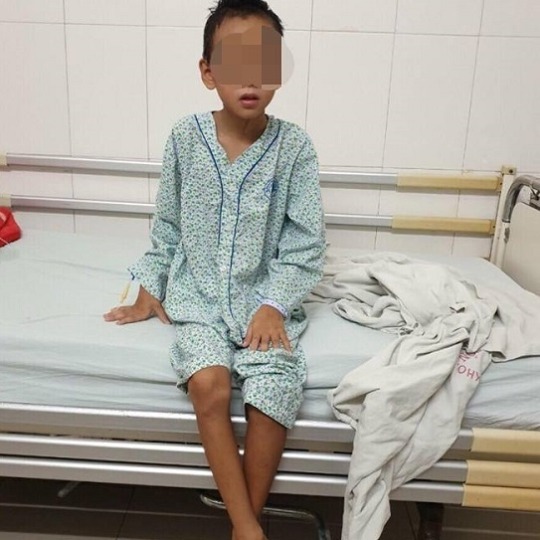
Hiện tại, sau ca phẫu thuật, bé trai đã ổn định sức khỏe, đang được điều trị tại bệnh viện. (Ảnh: Sức khỏe và Đời sống)
Kết quả cấy mủ, bác sĩ phát hiện bệnh nhi nhiễm cả 2 vi khuẩn Gram dương là Tụ cầu vàng (S. aureus) và Gram âm là B. pseudomallei ( vi khuẩn gây bệnh Whitmore).
Theo lời kể của gia đình, 3 tuần trước, bé bị một vết phỏng nước (dạng Herpes), gia đình đã tự điều trị tại nhà. Sau khi vết phỏng lành, bé liên tục dùng tay bẩn cạy vùng lên da non. Đây có thể là nguồn vào cho vi khuẩn gây bệnh Whitmore.
Bệnh Whitmore nguy hiểm thế nào?
Bệnh Meliodosis (Whitmore) gây ra bởi vi khuẩn gram âm Bacilus Burkholderia pseudomallei, đặc trưng bởi tình trạng viêm phổi nặng và áp xe đa ổ, với tỷ lệ tử vong cao lên tới 60%.
Đây là một bệnh truyền nhiễm cấp tính nguy hiểm, vi khuẩn gây bệnh sống trong bùn đất và nước, đường lây truyền chủ yếu qua vùng da tổn thương tiếp xúc với vi khuẩn hoặc hít phải các hạt bụi đất chứa vi khuẩn này.
Whitmore không có biểu hiện lâm sàng rõ ràng và thường bị chẩn đoán lâm sàng nhầm sang các bệnh khác. Bệnh cảnh lâm sàng thường gặp: Nhiễm khuẩn huyết, viêm phổi nặng, áp xe cơ, viêm tủy xương, viêm tuyến mang tai…
Những người có nguy cơ cao mắc bệnh là người có sử dụng thuốc đường tiêm truyền kéo dài hoặc người bị nhiễm khuẩn nặng ở những vùng lân cận như nhiễm trùng tiết niệu, nhiễm trùng từ phổi, máu…
Có 2 con đường chính lây nhiễm khuẩn: Một là qua tiếp xúc trực tiếp các vết xước trầy da với đất hoặc nước nhiễm khuẩn; hai là hít phải các hạt bụi có chứa vi khuẩn...
Vi khuẩn cũng có thể truyền từ mẹ sang con qua tuyến sữa nếu vú của người mẹ bị áp xe do vi khuẩn B. pseudomallei. Bệnh có thể lây nhiễm khi tiếp xúc vết xước trầy da với loại động vật chết do nhiễm bệnh Whitmore như chó, mèo, bò, dê, cừu và ngựa.
Bác sĩ Hùng khuyến cáo, hiện nay bệnh Whitmore chưa có vắc-xin phòng, nên mọi người chú ý giữ ấm đường hô hấp trong môi trường khói bụi, tăng cường biện pháp phòng hộ trong lao động, sinh hoạt tránh để da bàn chân, bàn tay, các bộ phận trong cơ thể tiếp xúc trực tiếp với đất bẩn.
(Tổng hợp)
from Đại Kỷ Nguyên - Feed - https://ift.tt/2Qbi5gQ
via IFTTT
0 notes
Text
god its been a month since my grandma has been hospitalised. she's been there since the start of eid :( she has this invasive bacteria collecting in her body "meliodosis" (?) and when they started switching her to oral antibiotics, her body reacted negativitely towards it and shes gotten sicker :( i hope she gets through this amin amin
#like 2 weeks ago she started eating by herself and she couldnt stop talking and now shes always in bed crying and wincing in pain#she says she rather lose her life than go through this pain#and it angers me so much that someone so full of life gets their health taken away to become this???#it reminds me again how health is so important and u cant be anything without it :(#personal but not so personal
0 notes
Text
Researchers turn to phages to control meliodosis
Researchers turn to phages to control meliodosis
An international research team from the University of Leicester from UK, Lomonosov Moscow State University (MSU), and the Moscow Institute of Physics and Technology (MIPT) from Russia has developed a mathematical model for monitoring and controlling the spread of melioidosis in Southeast Asia. The findings are presented in Scientific Reports, a prestigious journal from the publishers of Nature.
M…
View On WordPress
0 notes
Text
THE PENTAGON BIO-WEAPONS
Posted by M M | Jan 17, 2018 | 2018, Conspiracy, Cabal, and Government, Daily Blog, Government Laws, Policies, Politicians, Military, Military
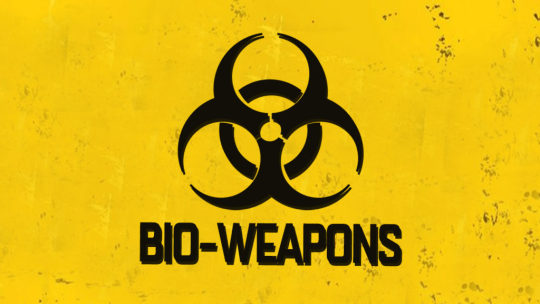
SOUTH FRONT
DilyanaGaytandzhieva is a Bulgarian investigative journalist and Middle East Correspondent. Over the last two years she has published a series of revealed reports on weapons smuggling. In the past year she came under pressure from the Bulgarian National Security Agency and was fired from her job in the Bulgarian newspaper Trud Daily without explanation. Despite this, Dilyana continues her investigations. Her current report provides an overview of Pentagon’s vigour in the development of biological weapons.
Twitter/@dgaytandzhieva
The US Army regularly produces deadly viruses, bacteria and toxins in direct violation of the UN Convention on the prohibition of Biological Weapons. Hundreds of thousands of unwitting people are systematically exposed to dangerous pathogens and other incurable diseases. Bio warfare scientists using diplomatic cover test man-made viruses at Pentagon bio laboratories in 25 countries across the world. These US bio-laboratories are funded by the Defense Threat Reduction Agency (DTRA) under a $ 2.1 billion military program– Cooperative Biological Engagement Program (CBEP), and are located in former Soviet Union countries such as Georgia and Ukraine, the Middle East, South East Asia and Africa.
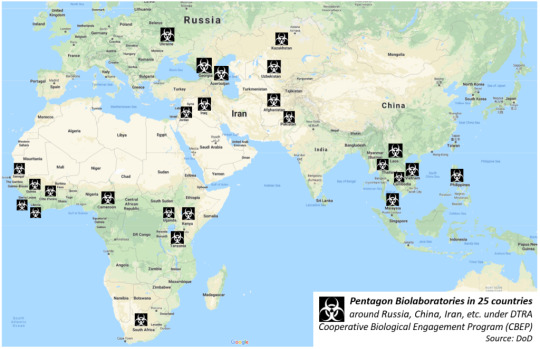
The Lugar Center, Republic of Georgia
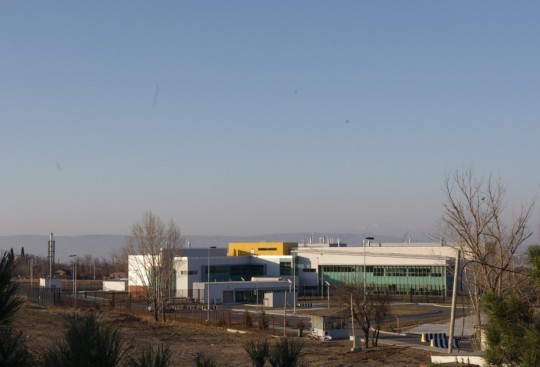
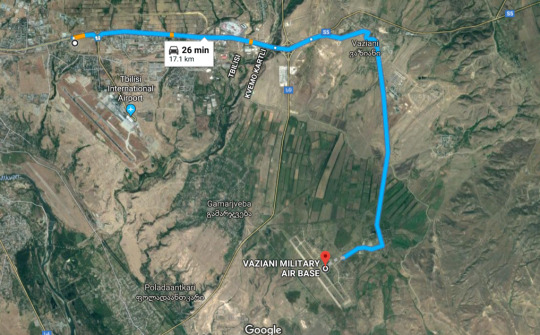
The US Army has been deployed to Vaziani Military Air Base, 17 km away from the Pentagon bio-laboratory at The Lugar Center.
Georgia is a testing ground for bioweapons
The Lugar Center is the Pentagon bio laboratory in Georgia. It is located just 17 km away from the US Vaziani military airbase in the capital Tbilisi. Tasked with the military program are biologists from the US Army Medical Research Unit-Georgia (USAMRU-G) along with private contractors. The Bio-safety Level 3 Laboratory is accessible only to US citizens with security clearance. They are accorded diplomatic immunity under the 2002 US-Georgia Agreement on defense cooperation.
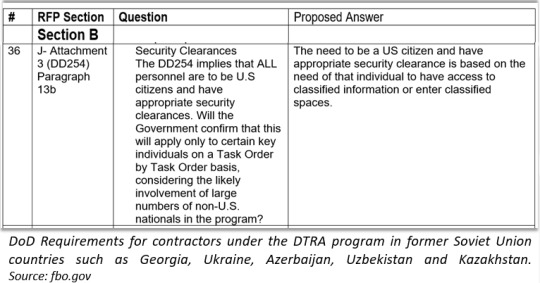
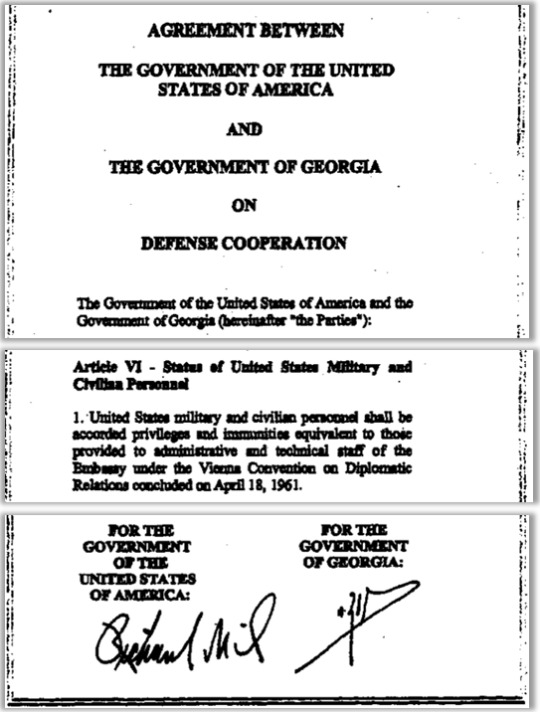
The USA-Georgia agreement accords diplomatic status to the US military and civilian personnel (including diplomatic vehicles), working on the Pentagon program in Georgia.
Information obtained from the US federal contracts registry clarifies some of the military activities at The Lugar Center – among them research on bio- agents (anthrax, tularemia) and viral diseases (e.g. Crimean-Congo Hemorrhagic Fever), and the collection of biological samples for future experiments.
Pentagon contractors produce bio agents under diplomatic cover
The Defense Threat Reduction Agency (DTRA) has outsourced much of the work under the military program to private companies, which are not held accountable to Congress, and which can operate more freely and move around the rule of law. US civilian personnel performing work at The Lugar Center have also been given diplomatic immunity, although they are not diplomats. Hence, private companies can perform work, under diplomatic cover, for the US government without being under the direct control of the host state – in this case the Republic of Georgia. This practice is often used by the CIA to provide cover for its agents.
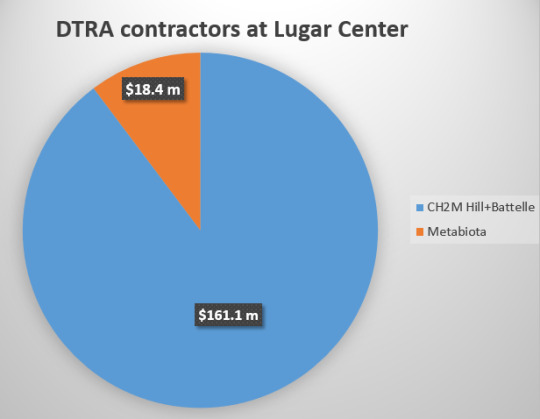
Three private American companies work at the US bio-laboratory in Tbilisi – CH2M Hill, Battelle and Metabiota. In addition to the Pentagon, these private contractors perform biological research for the CIA and various other government agencies.
CH2M Hill has been awarded $341.5 million DTRA contracts under the Pentagon’s program for bio-laboratories in Georgia, Uganda, Tanzania, Iraq, Afghanistan, South East Asia. Half of this sum ($161.1 million), being allocated to The Lugar Center, under the Georgian contract.
According to CH2M Hill, the US Company has secured biological agents and employed former bio warfare scientists at The Lugar Center. These are scientists who are working for another American company involved in the military program in Georgia – Battelle Memorial Institute.
Battelle as a $59 million subcontractor at Lugar Center has extensive experience in research on bio-agents, as the company has already worked on the US Bio-weapons Program under 11 previous contracts with the US Army (1952-1966).

Source: US Army Activities in the US, Biological Warfare Programs, vol. II, 1977, p. 82
The private company performs work for the Pentagon’s DTRA bio laboratories in Afghanistan, Armenia, Georgia, Uganda, Tanzania, Iraq, Afghanistan and Vietnam. Battelle conducts research, development, testing, and evaluation using both highly toxic chemicals and highly pathogenic biological agents for a wide range of US government agencies. It has been awarded some $2 billion federal contracts in total and ranks 23 on the Top 100 US government contractors list.
The CIA-Battelle Project Clear Vision
Project Clear Vision (1997 and 2000), a joint investigation by the CIA and the Battelle Memorial Institute, under a contract awarded by the Agency, reconstructed and tested a Soviet-era anthrax bomblet in order to test its dissemination characteristics. The project’s stated goal was to assess bio-agents dissemination characteristics of bomblets. The clandestine CIA-Battelle operation was omitted from the US Biological Weapons Convention declarations submitted to the UN.

Anthrax spores under microscope
Top Secret Experiments
Battelle has operated a Top Secret Bio laboratory (National Biodefense Analysis and Countermeasures Center – NBACC) at Fort Detrick, Maryland under a US Department of Homeland Security (DHS) contract for the last decade. The company has been awarded a $344.4 million federal contract (2006 – 2016) and another $17.3 million contract (2015 -2026) by DHS.
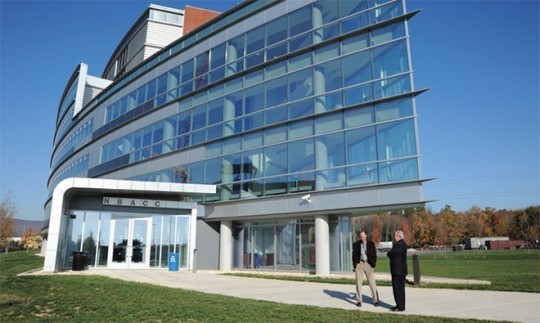
NBACC is classified as a US Top Secret facility. Photo Credit: DHS
Amongst the secret experiments, performed by Battelle at NBACC, are: Assessment of powder dissemination technology ; Assessment of hazard posed by aerosolized toxins and Assessment of virulence of B. Pseudomallei (Meliodosis) as a function of aerosol particle in non-human primates. Melioidosis has the potential to be developed as a biological weapon, hence, it is classed as a category B. Bioterrorism Agent. B. Pseudomallei was studied by the US as a potential bioweapon in the past.

Besides the military experiments at the Lugar Center in Georgia, Battelle has already produced bioterrorism agents at the Biosafety Level 4 NBACC Top Secret Laboratory at Fort Detrick in the US. A NBACC presentation lists 16 research priorities for the lab. Amongst them to characterize classical, emerging and genetically engineered pathogens for their BTA (biological threat agent) potential; assess the nature of nontraditional, novel and non-endemic induction of disease from potential BTA and to expand aerosol-challenge testing capacity for non-human primates.

Scientists engineer pathogens at the NBACC lab. Source: NBACC
Pentagon biolabs at the epicenter of the Ebola crisis
The US Company Metabiota Inc. has been awarded $18.4 million federal contracts under the Pentagon’s DTRA program in Georgia and Ukraine for scientific and technical consulting services.
Metabiota services include global field-based biological threat research, pathogen discovery, outbreak response and clinical trials.
Metabiota Inc. had been contracted by the Pentagon to perform work for DTRA before and during the Ebola crisis in West Africa and was awarded $3.1 million (2012-2015) for work in Sierra Leone – one of the countries at the epicenter of the Ebola outbreak.

Metabiota worked on a Pentagon’s project at the epicenter of the Ebola crisis, where three US biolabs are situated.
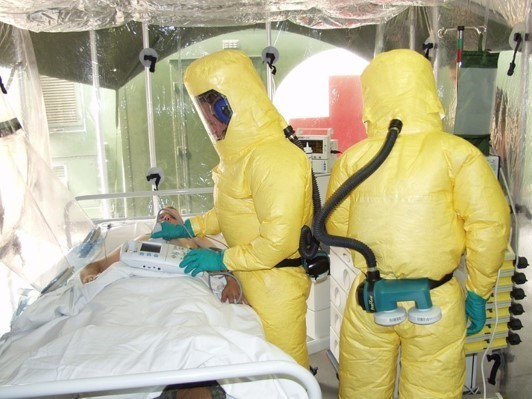
A July 17, 2014 report drafted by the Viral Hemorrhagic Fever Consortium, accused Metabiota Inc. of failing to abide by an existing agreement on how to report test results and for bypassing the Sierra Leonean scientists working there. The report also raised the possibility that Metabiota was culturing blood cells at the lab, something the report said was dangerous, as well as misdiagnosing healthy patients. All of those allegations were denied by Metabiota.
Click to see the full-size image
2011,The Lugar Center, Andrew C. Weber (on the right) – US Assistant Secretary of Defense (2009-2014), US DoD Deputy Coordinator for Ebola Response (2014-2015), is currently a Metabiota ( the US contractor) employee.
Military Experiments on biting insects
Entomological warfare is a type of biological warfare that uses insects to transmit diseases. The Pentagon has allegedly performed such entomological tests in Georgia and Russia.
Click to see the full-size image
Biting Flies in Georgia
In 2014 The Lugar Center was equipped with an insect facility and launched a project “Raising Awareness about Barcoding of Sand Flies in Georgia and Caucasus”. The project covered a larger geographic area outside of Georgia – Caucasus. In 2014-2015 Phlebotomine sand fly species were collected under another project “Surveillance Work on Acute Febrile Illness” and all (female) sand flies were tested to determine their infectivity rate. A third project, also including sand flies collection, studied the characteristics of their salivary glands.
A biting fly in a bathroom in Tbilisi. Flies in Georgia
As a result Tbilisi has been infested with biting flies since 2015. These biting insects live indoors, in bathrooms, all year long, which was not the typical behaviour of these species in Georgia previously (normally the Phlebotomine fly season in Georgia is exceptionally short – from June to September). Local people complain of being bitten by these newly appeared flies while naked in their bathrooms. They also have a strong resistance to cold and can survive even in the sub-zero temperatures in the mountains.
Biting Flies in Dagestan, Russia
Since the start of the Pentagon project in 2014 flies similar to those in Georgia have appeared in neighboring Dagestan (Russia). According to local people, they bite and cause rashes. Their breeding habitats are house drains.
Click to see the full-size image
Click to see the full-size image
Flies in Georgia (on the left). The same fly in Dagestan (on the right)
Flies from the Phlebotomine family carry dangerous parasites in their saliva which they transmit through a bite to humans. The disease, which these flies carry, is of high interest to the Pentagon. In 2003 during the US invasion of Iraq American soldiers were severely bitten by sand flies and contracted Leishmoniasis. The disease is native to Iraq and Afghanistan and if left untreated the acute form of Leishmoniasis can be fatal.
A 1967 US Army report “Arthropods of medical importance in Asia and the European USSR” lists all local insects, their distribution and the diseases that they carry. Biting flies, which live in drains, are also listed in the document. Their natural habitats, though, are the Philippines, not Georgia or Russia.
Click to see the full-size image
Source: “Arthropods of medical importance in Asia and the European USSR”, US Army report, 1967
Operation Whitecoat: Infected flies tested to bite humans
Click to see the full-size image
In 1970 and 1972, Sand Fly Fever tests were performed on humans according to a declassified US Army report – US Army Activities in the US, Biological Warfare Programs, 1977, vol. II, p. 203.During operation Whitecoat volunteers were exposed to bites by infected sand flies. Operation Whitecoat was a bio-defense medical research program carried out by the US Army at Fort Detrick, Maryland between 1954 and 1973.
Despite the official termination of the US bio-weapons program, in 1982 USAMRIID performed an experiment if sand flies and mosquitoes could be vectors of Rift Valley Virus, Dengue, Chikungunya and Eastern Equine Encephalitis – viruses, which the US Army researched for their potential as bio-weapons.
Killer Insects
A. Aegypti
The Pentagon has a long history in using insects as vectors for diseases. According to a partially declassified 1981 US Army report, American bio warfare scientists carried out a number of experiments on insects. These operations were part of the US Entomological Warfare under the Program for Biological Weapons of the US.
The Pentagon: How to kill 625,000 people for just $0.29 cost per deat
A US Army report in 1981 compared two scenarios – 16 simultaneous attacks on a city by A. Aegypti mosquitoes, infected with Yellow Fever, and Tularemia aerosol attack, and assesses their effectiveness in cost and casualties.
Click to see the full-size image
Click to see the full-size image
Operation Big Itch: Field tests were performed to determine coverage patterns and survivability of the tropical rat flea Xenopsylla cheopis for use as a disease vector in biological warfare.
Operation Big Buzz: 1 million A. Aegypti mosquitoes were produced, 1/3 were placed in munitions and dropped from aircraft, or dispersed on the ground. The mosquitoes survived the airdrop and actively sought out human blood.
Click to see the full-size image
Source: Evaluation of Entomological Warfare as a potential Danger to the US and European NATO nations, US Army, March 1981 Report
Operation May Day: Aedes Aegypti mosquitoes were dispersed through ground based methods in Georgia, USA, during a US Army operation codenamed May Day.
Click to see the full-size image
Parts of the 1981 US Army report such as the “Mass production of Aedes Aegypti” have not been declassified, potentially meaning that the project is still ongoing.
Aedes Aegypti, also known as yellow fever mosquito, have been widely used in US military operations. The same species of mosquitoes are alleged to be the vectors of dengue, chikungunya and the Zika virus, which causes genetic malformations in newborns
Operation Bellweather
The US Army Chemical Research and Development Command, Biological Weapons Branch, studied outdoor mosquito biting activity in a number of field tests at Dugway Proving Ground, Utah, in 1960. Virgin female Aedes aegypti mosquitoes, which had been starved, were tested upon troops out in the open air.
Click to see the full-size image
For reference: Outdoor Mosquito Biting Activity Studies, Project Bellweather I, 1960, Technical Report, US Army, Dugway Proving Ground
Military Experiments with Tropical Mosquitoes and Ticks in Georgia
Such species of mosquitoes and fleas (studied in the past under the US Entomological Warfare Program) have also been collected in Georgia and tested at The Lugar Center.
Under the DTRA project “Virus and Other Arboviruses in Georgia” in 2014 the never-before-seen tropical mosquito Aedes albopictus was detected for the first time and after decades (60 years) the existence of Aedes Aegypti mosquito was confirmed in West Georgia.
Click to see the full-size image
Aedes Albopictus is a vector of many viral pathogens, Yellow fever virus, Dengue, Chikungunya and Zika.
These tropical mosquitoes Aedes Albopictus having never been seen before in Georgia, have also been detected in neighboring Russia (Krasnodar) and Turkey, According to data provided by the European Centre for Disease Prevention and Control, Their spread is unusual for this part of the world.
Click to see the full-size image
Aedes Aegypti Mosquitoes have been distributed only in Georgia, Southern Russia and Northern Turkey. They were detected for the first time in 2014 after the start of the Pentagon program at The Lugar Center.
Click to see the full-size image
Under another DTRA project “Epidemiology and Ecology of Tularemia in Georgia” (2013-2016) 6,148 ground ticks were collected ; 5,871 were collected off the cattle and 1,310 fleas and 731 ticks were caught. In 2016 a further 21 590 ticks were collected and studied at The Lugar Center.
Anthrax Outbreak in Georgia and NATO Human Trials
In 2007 Georgia ended its policy of having compulsory annual livestock anthrax vaccination. As a result, the morbidity rate of the disease reached its peak in 2013. The same year NATO started human based anthrax vaccine tests at The Lugar Center in Georgia.
Click to see the full-size image
In 2007 despite the anthrax outbreak the Georgian government terminated the compulsory vaccination for 7 years, 2013 saw NATO start human trials on a new anthrax vaccine in Georgia.
Click to see the full-size image
Pentagon Research on Russian Anthrax
Anthrax is one of the bio agents weaponized by the US Army in the past. Despite the Pentagon’s claims that its program is only defensive, there are facts to the contrary. In 2016 at The Lugar Center American scientists carried out research on the “Genome Sequence of the Soviet/Russian Bacillus anthracis Vaccine Strain 55-VNIIVViM”, which was funded by the U.S. Defense Threat Reduction Agency’s (DTRA) Cooperative Biological Engagement Program in Tbilisi, and administered by Metabiota (the US contractor under the Pentagon program in Georgia).
In 2017 the DTRA funded further research – Ten Genome Sequences of Human and Livestock Isolates of Bacillus anthracis from the Country of Georgia, which was performed by USAMRU-G at The Lugar Center.
34 people intentionally infected with Crimean-Congo Hemorrhagic Fever (CCHF) in Georgia
Crimean-Congo hemorrhagic fever (CCHF) is caused by infection through a tick-borne virus (Nairovirus). The disease was first characterized in Crimea in 1944 and given the name Crimean hemorrhagic fever. It was then later recognized in 1969 as the cause of illness in Congo, thus resulting in the current name of the disease. In 2014 34 people became infected (among which a 4-year old child) with CCHF. 3 of which died. The same year Pentagon biologists studied the virus in Georgia under the DTRA project “Epidemiology of febrile illnesses caused by Dengue viruses and other Arboviruses in Georgia”. The project included tests on patients with fever symptoms and the collection of ticks, as possible vectors of CCHV for laboratory analysis.
Click to see the full-size image
33 people became infected with CCHF, 3 of them died in Georgia.
Source: NCDC-Georgia
The cause of the CCHF outbreak in Georgia is still unknown. According to the local Veterinary Department report, only one tick from all of the collected species from the infected villages tested positive for the disease. Despite the claims of the local authorities that the virus was transmitted to humans from animals, all animal blood samples were negative too. The lack of infected ticks and animals is inexplicable given the sharp increase of CCHF human cases in 2014, meaning that the outbreak was not natural and the virus was spread intentionally.
In 2016 another 21 590 ticks were collected for DNA database for future studies at The Lugar Center under the Pentagon project “Assessing the Seroprevalence and Genetic Diversity of Crimean-Congo Hemorrhagic Fever Virus (CCHFV) and Hantaviruses in Georgia”.
Symptoms of CCHF
Military bio-lab blamed for deadly CCHF outbreak in Afghanistan
237 cases of Crimean-Congo Hemorrhagic Fever (CCHF) have also been reported across Afghanistan, 41 of which were fatal as of December 2017. According to Afghanistan’s Ministry of Health most of the cases have been registered in the capital Kabul where 71 cases have been reported with 13 fatalities, and in the province of Herat near the border with Iran (67 cases).
Click to see the full-size image
Click to see the full-size image
Afghanistan is one of 25 countries across the world with Pentagon bio-laboratories on their territory. The project in Afghanistan is part of the US bio-defense program – Cooperative Biological Engagement Program (CBEP), which is funded by the Defense Threat Reduction Agency (DTRA). The DTRA contractors, working at The Lugar Center in Georgia, CH2M Hill and Battelle have also been contracted for the program in Afghanistan. CH2M Hill has been awarded a $10.4 million contract (2013-2017). The Pentagon contractors in Afghanistan and Georgia are the same and so are the diseases which are spreading among the local population in both countries.
Why the Pentagon collects and studies bats
Bats are allegedly the reservoir hosts to the Ebola Virus , Middle East Respiratory Syndrome (MERS) and other deadly diseases. However, the precise ways these viruses are transmitted to humans are currently unknown. Numerous studies have been performed under the DTRA Cooperative Biological Engagement Program (CBEP) in a search for deadly pathogens of military importance in bats.
Click to see the full-size image
221 bats were euthanized at the Lugar Center for research purposes in 2014.
Click to see the full-size image
Bats have been blamed for the deadly Ebola outbreak in Africa (2014-2016). However, no conclusive evidence of exactly how the virus “jumped” to humans has ever been provided, which raises suspicions of intentional and not natural infection.
Engineering deadly viruses is legal in the US
MERS-CoV is thought to originate from bats and spread directly to humans and/or camels. However, like Ebola, the precise ways the virus spreads are unknown.
1,980 cases with 699 deaths were reported in 15 countries across the world (as of June 2017) caused by MERS-CoV.
3 to 4 out of every 10 patients reported with MERS have died. Source: WHO
MERS-CoV is one of the viruses that have been engineered by the US and studied by the Pentagon, as well as Influenza and SARS. Confirmation of this practice is Obama’s 2014 temporary ban on government funding for such “dual-use” research. The moratorium was lifted in 2017 and experiments have continued. Enhanced Potential Pandemic Pathogens (PPPs) experiments are legal in the US.
Such experiments aim to increase the transmissibility and/or virulence of pathogens.
Tularemia as Bioweapon
Tularemia, also known as Rabbit Fever, is classified as a bioterrorism agent and was developed in the past as such by the US. However, the Pentagon’s research on tularemia continues, as well as on possible vectors of the bacteria such as ticks and rodents which cause the disease. The DTRA has launched a number of projects on Tularemia along with other especially dangerous pathogens in Georgia. Especially Dangerous Pathogens (EDPs), or select agents, represent a major concern for the public health globally. These highly pathogenic agents have the potential to be weaponized with proof of their military importance seen through the following Pentagon projects: Epidemiology and Ecology of Tularemia in Georgia (2013-2016) (60 000 vectors were collected for strain isolates and genome research); Epidemiology of Human Tularemia in Georgia and Human Disease Epidemiology and Surveillance of Especially Dangerous Pathogens in Georgia (study of select agents among patients with undifferentiated fever and hemorrhagic fever/septic shock).
Click to see the full-size image
F. Tularensis is a highly infectious bacterium and has the potential to be weaponized for use through aerosol attacks.
Click to see the full-size image
Click to see the full-size image
Tularemia is one of the bio-weapons that the US Army developed in the past.
Source: 1981 US Army Report
Pentagon bio-laboratories spread diseases in Ukraine
Click to see the full-size image
The DoD Defense Threat Reduction Agency (DTRA) has funded 11 bio-laboratories in the former Soviet Union Country Ukraine, bordering on Russia.
Click to see the full-size image
Click to see the full-size image
Click to see the full-size image
Click to see the full-size image
Click to see the full-size image
Click to see the full-size image
Click to see the full-size image
Click to see the full-size image
Click to see the full-size image
Click to see the full-size image
Click to see the full-size image
The US military program is sensitive information
Ukraine has no control over the military bio-laboratories on its own territory. According to the 2005 Agreement between the US DoD and the Ministry of Health of Ukraine the Ukrainian government is prohibited from public disclosure of sensitive information about the US program and Ukraine is obliged to transfer to the US Department of Defense (DoD) dangerous pathogens for biological research. The Pentagon has been granted access to certain state secrets of Ukraine in connection with the projects under their agreement.
Click to see the full-size image
Click to see the full-size image
Biowarfare scientists under diplomatic cover
Among the set of bilateral agreements between the US and Ukraine is the establishment of the Science and Technology Center in Ukraine (STCU) – an International organization funded mainly by the US government which has been accorded diplomatic status. The STCU officially supports projects of scientists previously involved in the Soviet biological weapons program. Over the past 20 years the STCU has invested over $285 million in funding and managing some 1,850 projects of scientists who previously worked on the development of weapons of mass destruction.
Click to see the full-size image
The US personnel in Ukraine work under diplomatic cover.
364 Ukrainians died from Swine Flu
One of the Pentagon laboratories is located in Kharkiv, where in January 2016 at least 20 Ukrainian soldiers died from Flu-like virus in just two days with 200 more being hospitalized. The Ukrainian government did not report on the dead Ukrainian soldiers in Kharkiv. As of March 2016 364 deaths have been reported across Ukraine (81.3 % caused by Swine Flu A (H1N1) pdm09 – the same strain which caused the world pandemic in 2009).
Click to see the full-size image
According to DPR intelligence information the US bio lab in Kharkiv leaked the deadly virus.
Police investigate infection with incurable disease
A highly suspicious Hepatitis A infection spread rapidly in just few months across South East Ukraine where most of the Pentagon biolabs are located.
Click to see the full-size image
37 people have been hospitalized for Hepatitis A in the Ukrainian city of Mykolaiv as of January 2018. Local police have launched an investigation into “infection with human immunodeficiency virus and other incurable diseases”. Three years ago more than 100 people in the same city became infected with Cholera. Both diseases are alleged to have spread through contaminated drinking water.
In the summer of 2017 60 people with Hepatitis A were admitted to hospital in the city of Zaporizhia, the cause of this outbreak is still unknown.
In the Odessa region, 19 children from an orphanage were hospitalized for hepatitis A in June 2017.
29 cases of Hepatitis A were reported in Kharkiv in November 2017. The virus was isolated in contaminated drinking water. One of the Pentagon bio-labs is located in Kharkiv which was blamed for the deadly Flu outbreak a year ago which claimed the lives of 364 Ukrainians.
Ukraine and Russia hit by new highly virulent cholera infection
In 2011 Ukraine was hit by a cholera outbreak. 33 patients were reportedly hospitalized for severe diarrhea. A second outbreak struck the country in 2014 when more than 800 people all across Ukraine were reported to have contracted the disease. In 2015 at least 100 new cases were registered in the city of Mykolaiv alone.
Click to see the full-size image
A new highly virulent variant of the cholera agent Vibrio cholera, with a high genetic similarity to the strains reported in Ukraine, hit Moscow in 2014. According to a 2014 Russian Research Anti-Plaque Institute genetic study the cholera strain isolated in Moscow was similar to the bacteria which caused the epidemic in neighboring Ukraine.
Southern Research Institute one of the US contractors working at the bio-laboratoriesin Ukraine, has projects on Cholera, as well as on Influenza and Zika – all pathogens of military importance to the Pentagon.
Along with Southern Research Institute, two other private American companies operate military bio-labs in Ukraine – Black&Veatch and Metabiota.
Click to see the full-size image
Black & Veatch Special Project Corp. was awarded $198.7 million DTRA contracts to build and operate bio-laboratories in Ukraine (under two 5-year contracts in 2008 and 2012 totaling $128.5 million), as well as in Germany, Azerbaijan, Cameroon, Thailand, Ethiopia, Vietnam and Armenia.
Metabiota has been awarded a $18.4 million federal contract under the program in Georgia and Ukraine. This US company was also contracted to perform work for the DTRA before and during the Ebola crisis in West Africa, the company was awarded $3.1 million (2012-2015) for work in Sierra Leone .
Southern Research Institute has been a prime subcontractor under the DTRA program in Ukraine since 2008. The company was also a prime Pentagon contractor in the past under the US Biological Weapons Program for research and development of bio-agents with 16 contracts between 1951 and 1962.
Source: US Army Activities in the US, Biological Warfare Programs, vol. II, 1977, p. 82
Soviet Defector produced anthrax for the Pentagon
Click to see the full-size image
Southern Research Institute was also a subcontractor on a Pentagon program for anthrax research in 2001. The prime contractor being Advanced Biosystems, whose president at that time was Ken Alibek (a former Soviet microbiologist and biological warfare expert from Kazakhstan who defected to the US in 1992).
Bacillus anthracis, magnified more than 12,000 times
Ken Alibek
Ken Alibek was the First Deputy Director of Biopreparat, where he oversaw a program for biological weapon facilities and was the Soviet Union’s main expert on anthrax. After his defection to the US, he was engaged on Pentagon research projects.
$250 000 for lobbying Jeff Sessions for “research for US intelligence”
Southern Research Institute lobbied the US Congress and US Department of State hard for “issues related to research and development for US intelligence” and “defense related research and development”. The lobbying activities coincided with the start of the Pentagon projects on bio-labs in Ukraine and other former Soviet states.
The company paid $ 250 000 for lobbying the then Senator Jeff Sessions in 2008-2009 (currently the US Attorney General appointed by Donald Trump), when the institute was awarded a number of federal contracts.
Click to see the full-size image
US Attorney General Jeff Sessions, US Senator from Alabama (1997-2017)
Watson Donald
For a 10-year period (2006-2016) Southern Research Institute paid $1.28 million for lobbying the US Senate, House of Representatives , the State Department and the Department of Defense (DoD). Senator Jeff Sessions’ aide on Capitol Hill – Watson Donald, is now a Senior Director at Southern Research Institute.
Police investigate Botulism toxin poisoning in Ukraine
115 Botulism cases, with 12 deaths, were reported in Ukraine in 2016.
Click to see the full-size image
In 2017 the Ukrainian Ministry of Health confirmed a further 90 new cases, with 8 deaths, of botulinum toxin poisoning (one of the most poisonous biological substances known). According to the local health authorities, the cause of the outbreak was food poisoning into which police launched an investigation .
The Ukrainian government stopped supplying antitoxin in 2014 and no botulism vaccines in stock were available during the 2016-2017 outbreak.
Botulism is a rare and extremely dangerous illness caused by a toxin produced by the bacterium Clostridium botulinum.
1 gm of the toxin can kill as many as 1 million people
Click to see the full-size image
Botulinum neurotoxin poses a major bio-weapon threat because of its extreme potency, ease of production and transport. It causes muscles paralyses, respiratory failure and ultimately death if not treated immediately. A single gram of crystalline toxin, evenly dispersed and inhaled can kill more than one million people. It could be disseminated via aerosol, or by contamination of water and/ or food supplies.
The Pentagon produces live Viruses, Bacteria & Toxins
Botulinum Toxin was tested as a bio-weapon by the US Army in the past, as well as Anthrax, Brucella and Tularemia. Although the US bio-weapons program was officially terminated in 1969 documents show that the military experiments have never ended. Presently the Pentagon produces and tests live bio- agents at the same military facility as it did in the past – Dugway Proving Ground.
Current Field Tests
Source: Capabilities Report 2012, West Desert Test Center
Past Field Tests
Source: 1977 US Army Report, p. 135
Bioweapons factory in the US
The US Army produces and tests bio-agents at a special military facility located at Dugway Proving Ground ( West Desert Test Center, Utah), as proven in a 2012 US Army Report. The facility is overseen by the Army Test and Evaluation Command.
The Life Sciences Division (LSD) at Dugway Proving Ground is tasked with the production of bio-agents. According to the Army report, scientists from this division produce and test aerosolized bio-agents at Lothar Saloman Life Sciences Test Facility (LSTF).
Photo Credit: Dugway Proving Ground
Lothar Saloman Life Sciences Test Facility (LSTF) where bio-terrorism agents are produced and aerosolized.
Source: Capabilities Report 2012, West Desert Test Center
Biological Agents produced by the US Army at Dugway Proving Ground, Utah, USA
The Life Sciences Division consists of an Aerosol Technology branch and a Microbiology Branch. The Aerosol Technology Branch aerosolizes biological agents and simulants. The Microbiology branch produces toxins, bacteria, viruses and agent-like organisms which are used in chamber and field testing.
Click to see the full-size image
Click to see the full-size image
The fermentation laboratories at the Life Sciences Test Facility grow bacteria in fermentors ranging from a small 2 L to a large 1500 L system. The fermentors are tailored specifically to the requirements of the microorganism that is being engineered – pH, temperature, light, pressure, and nutrient concentrations that give the microorganism optimal growth rates.
A large 1500 L fermentator. Photos credit: Dugway Proving Ground
A post-production laboratory dries and mills test materials. Photos credit: Dugway Proving Ground
After the bio-agents are produced, the scientists challenge them at containment aerosol chambers.
Technicians disseminate live biological agents for identification sensitivity tests. Photos Credit: Dugway Proving Ground
Technicians disseminate live biological agents for identification sensitivity tests. Photos Credit: Dugway Proving Ground
Technicians disseminate live biological agents for identification sensitivity tests. Photos Credit: Dugway Proving Ground
Aerosol experiments with Botulinum Neurotoxin and Anthrax
Documents prove that the US Army produces, possesses and tests aerosols of the most lethal toxin in the world – Botulinum Neurotoxin. In 2014 the Department of the Army purchased 100 mg of Botulinum Toxin from Metabiologics for tests at Dugway Proving Ground.
The experiments date back to 2007 when an unspecified quantity of the toxin was procured to the Department of the Army by the same company – Metabiologics. According to the 2012 West Desert Test Center Report, the military facility performs tests with Botulinum Neurotoxin Aerosol, as well as with aerosolized Anthrax, Yersinia pestis, and Venezuelan Equine Encephalitis Virus (VEE).
Source: Capabilities Report 2012, West Desert Test Center
Outdoor field test programs at Dugway Proving Ground
US Army documents and photos show that the Pentagon has developed various dissemination methods for bioterrorism attacks including by explosives.
Source: Capabilities Report 2012, West Desert Test Center
Dissemination of contaminants for biological/chemical tests. Photo credit: Dugway Proving Ground
Dissemination of contaminants for biological/chemical tests. Photo credit: Dugway Proving Ground
Liquid Dissemination. Photos Credit: Dugway Proving Ground
Powder Dissemination. Photos Credit: Dugway Proving Ground
Dissemination on the test grid. Photos Credit: Dugway Proving Ground
The US Army report lists numerous dissemination techniques including by bio-aerosol sprayers. Such sprayers called Micronair disseminators have already been developed by the US Army and tested at Dugway Proving Ground. According to the documents, they can be vehicle-mounted, or worn as a backpack, with a pump system which can be fitted to the unit to increase the accuracy of the release. Micronair sprayers can release 50 to 500 mL of bio-liquid simulant per minute from 12 L tanks.
Aerosol Sprayers. Photo credit: Dugway Proving Ground
The US stole bacteria from Saddam Hussein’s bio weapons factory
Bacillus thuringiensis is an insect pathogen that is widely used as a bio-pesticide. B. thuringiensis (BT) Al Hakam was collected in Iraq by the UN Special Commission led by the US in 2003. It is named after Al Hakam – Iraq’s bio-weapons production facility. Apart from Pentagon field tests, this bacterium is also used in the US for the production of GM corn, resistant to pests. Photos posted by the CIA prove that the bacteria was collected by the US in Iraq. According to the CIA, the vials containing bio-pesticide, were recovered from an Al Hakam scientist’s home.
CIA: A total of 97 vials-including those with labels consistent with the al Hakam cover stories of single-cell protein and bio-pesticides, as well as strains that could be used to produce BW agents were recovered from a scientist’s residence in Iraq in 2003.
Photo Credit: CIA
Bacillus thuringiensis
Information from the US federal contracts registry shows that the Pentagon performs tests using the bacteria stolen from Saddam Hussein’s bio-weapons factory in Iraq.
The Defense Threat Reduction Agency (DTRA) federal project for laboratory analysis and field tests with bacteria. Source: govtribe.com
The tests are performed on Kirtland Air Force Base (Kirtland is the home of the Air Force Materiel Command’s Nuclear Weapons Center). Here weapons are being tested, meaning that the field tests with biological simulants (bacteria) also fall into this group.
The DTRA contractor on this project – Lovelace Biomedical and Environmental Research Institute (LBERI), operates an Animal Bio-safety 3 Level (ABSL-3) laboratory which has Select Agent status. The facility is designed to conduct bioaerosol studies. The company has been awarded a 5-year contract for field tests with biological simulants at Kirtland Air Force Base.
Photo Credit: Kirtland Air Force Base. Photo credit: Dugway Proving Ground
Some of the tests are performed in a wind tunnel. Photo credit: Dugway Proving Ground
Field tests with Biological Simulants (bacteria)
What the Pentagon is now doing is exactly what it did in the past, meaning that its bio-weapons program was never terminated. The US Army performed 27 field tests with such biological simulants, involving the public domain from1949 to 1968, when President Nixon officially announced the end of the program.
Click to see the full-size image
Click to see the full-size image
Source: US Army Activities in the US, Biological Warfare Programs, vol. II, 1977, p. 125-126
Field tests in Chechnya
The Defense Threat Reduction Agency (DTRA), which runs the US military program at the Lugar Center in Georgia, is alleged to have already performed field tests with an unknown substance in Chechnya, Russia. In the spring of 2017 local citizens reported on a drone disseminating white powder close to the Russian border with Georgia. Neither the Georgian border police, nor the US personnel operating on the Georgia-Russia border, commented on this information.
$9.2 million US military project on Russia-Georgia border
DTRA has full access to the Russia-Georgia border, granted under a military program called “Georgia Land Border Security Project”. The activities, related to the project have been outsourced to a private American company – Parsons Government Services International. DTRA has previously contracted Parsons for similar border security projects in Lebanon, Jordan, Libya and Syria. Parsons have been awarded a $9.2 million contract under the Pentagon border security project on the Russia-Georgia border.
Click to see the full-size image
Local citizens in Chechnya noticed a UAV sprayer near the Russian border with Georgia in 2017.
US Defense Agency tests GM Insects to transmit GM Viruses
The Pentagon has invested at least $65 million in gene editing. The US Defense Advanced Research Projects Agency (DARPA) has awarded 7 research teams to develop tools for genome engineering in insects, rodents and bacteria under DARPA’s Safe Gene program, using a novel CRISPR-Cas9 technology.
Click to see the full-size image
Click to see the full-size image
Under another military program –Insect Allies, GM insects are engineered to transfer modified genes to plants. The $10.3 million DARPA project includes both gene editing in insects and in the viruses that they transmit. Ecological Niche-preference Engineering is a third ongoing military program for genome engineering in insects. The Pentagon’s stated objective is to engineer GM organisms so that they can resist certain temperatures, change their habitat and food sources.
Source:fbo.gov
Genetically engineered humans
Besides gene editing in insects and in the viruses they transmit, the Pentagon wants to engineer humans as well.
DARPA Advanced Tools for Mammalian Genome Engineering Project seeks to create a biological platform inside the human body, using it to deliver new genetic information, and thus altering humans at the DNA level.
DARPA wants to insert an additional 47th artificial chromosome into human cells. This chromosome will deliver new genes that will be used for engineering the human body. SynPloid Biotek LLChas been awarded two contracts under the program totaling $1.1 million (2015-2016 – $ 100,600 for the first phase of the research; 2015-2017 – $ 999,300 for work which is not specified in the federal contracts registry. The company has only two employees and no previous record on bio-research.
Top Secret Research on Synthetic Viruses
Between 2008 and 2014, the United States invested approximately $820 million in synthetic biology research, Defense being a major contributor. Much of the military projects on synthetic biology are classified, among them are a number of classified studies by the secretive JASON group of US military advisors – e.g. Emerging Viruses and Genome Editing for the Pentagon, and Synthetic Viruses for the National Counterterrorism Center.
JASON is an independent scientific advisory group that provides consulting services to the U.S. government on matters of defense science and technology. It was established in 1960 and most of their resulting JASON reports are classified. For administrative purposes, the JASON’s projects are run by the MITRE Corporation, which has contracts with the Defense Department, CIA and the FBI. Since 2014 MITRE has been awarded some $27.4 million in contracts with the DoD.
Although the JASON Reports are classified, another US Air Force study titled Biotechnology: Genetically Engineered Pathogens, sheds some light on what the secretive JASON group has researched – 5 groups of genetically engineered pathogens that can be used as bio-weapons. These are binary biological weapons (a lethal combination of two viruses), host swapping diseases (animal viruses that “jump” to humans, like the Ebola virus), stealth viruses, and designer diseases. Designer diseases can be engineered to target a certain ethnic group, meaning that they can be used as ethnic bio-weapons.
Ethnic Bioweapons
Ethnic biological weapon (biogenetic weapon) is a theoretical weapon that aims to primarily harm people of specific ethnicities, or genotypes.
Although officially the research and development of ethnic bio-weapons have never been publicly confirmed, documents show that the US collects biological material from certain ethnic groups – Russians and Chinese.
The US Air Force has been specifically collecting Russian RNA and synovial tissue samples, raising fears in Moscow of a covert US ethnic bio-weapons program.
Source: fbo.gov
Apart from Russians, the US has been collecting biological material from both healthy and cancer patients in China. The National Cancer Institute has collected biological samples from 300 subjects from Linxian, Zhengzhou, and Chengdu in China. While another federal project, titled Serum Metabolic biomarkers discovery study of Esophageal Squamous Cell Carcinoma in China, includes analysis of 349 serum samples which have been collected from Chinese patients.
Click to see the full-size image
The US National Cancer Institute has been collecting biological material from patients of the Chinese Cancer Hospital in Beijing.
Chinese biological material has been collected under a series of federal projects including saliva and cancer tissue. Among them, Genotyping DNA Samples from Lymphoma cases and from controls (healthy patients), Breast cancer tissue blocks from breast cancer patients, Saliva samples of 50 families who have 3 or more cases of UGI cancer, Genotype 50 SNP’S for DNA samples from the Cancer Hospital, Beijing, Genotypes from 3000 cases of gastric cancer and 3000 controls (healthy patients) in Beijing.
Tobacco Vaccines
How the Pentagon helped tobacco companies to profit from Ebola
The Defense Advanced Research Projects Agency (DARPA) has invested $100 million in vaccines production from tobacco plants.
The companies, involved in the project, are owned by the biggest American tobacco companies – Mediacago Inc. is co-owned by Philip Morris and Kentucky BioProcessing, a subsidiary of Reynolds American which is owned by British American Tobacco. Currently they are producing Flu and Ebola vaccines from tobacco plants.
The $100 million program Blue Angel was launched as a response to the H1N1 pandemic in 2009. Medicago being awarded $21 million to produce 10, 000 million doses of an influenza vaccine within one month.
Blue Angel program manager Dr. John Julias explains: “Although there are multiple plant species and other organisms being explored as alternative protein production platforms, the US Government has continued to make an investment in tobacco-based manufacturing.”
Photos credit: DARPA
The plant-based vaccine production method works by isolating a specific antigen protein that triggers a human immune response from the targeted virus. A gene from the protein is transferred to bacteria, whichis used to infect plants. The plants then start producing the protein that will be used for vaccinations.
It is not clear why the Pentagon choses to invest in vaccines produced from tobacco plants amongst all other plant species, which they explored. Medicago, co-owned by Philip Morris, paid $495,000 for lobbying the Department of Defense, the Congress and The Department of Health and Human Services for “funding to advance technology to support public health preparedness applications”. The Pentagon funded tobacco companies to develop new technology and to profit from vaccines.
Biological Experiments are war crimes
Article 8 of The Rome Statute of The International Criminal Court (ICC) defines biological experiments as war crimes. The US, however, is not a state party to the international treaty, and cannot be held accountable for its war crimes.
0 notes
Text
Biological Disaster
Biological disaster
--------------------
( BDLS & ADLS)
Factors that compose the "chain of infection"
1. Infectious agent
- the greater virulence,invassiveness & pathogenicity --> the greater possibility organism will cause infection
2. Reservoirs
- the infectious agent normally lives & multiply , can reproduce itself & transmitted to susceptible host
3. Portal of exit
- biological agent leave the reservoir
4. Mode of transmission
- mechanism which infectious agent is spread
- can be airborne,droplet , direct & indirect physical contact, fecal oral transmission , vector mediated transmission
5. Portal of entry
- infectious agent enter host through skin,mucous membrane, lung. GIT, genito urinary , placenta , invasive procedure
6. Susceptible host
- influence by factors:
1, hod defense characteristic
2. Medical condition immunocompramised
3. Malnutrition
4. Pregnancy
5. Age
6. Increase exposure risk
7. Behavior factors
Biological disaster
---------------------
Epidemic:
- illness that occur in higher number that expected within a country & region.
Pandemic:
- worldwide epidermic disease
- 3 condition:
1. New disease emerges to a population has little or no immunity.
2. Disease is infectious for humans
3. Disease spreads easily among humans
Bioterrorism
Criminal act that causes illness, both law enforcement & public health authorities have responsibility to responds .
Intention use of biological agent to harm human or living organism.
- inexpensive
- easy to produce
- easy to disguised
- difficult to defend
Potential BT threats
----------------------
Category A: high priority agents
- easily disseminated
- high mortality
- causes public panic
- require public health for special action
Eg antarax,botulism,plaque,small pox & tularemia, viral haemorrhagic fevers
Category B: second priority agents
- moderate easy to disseminate
- moderate morbidity & low mortality
- require enhancement of CDC
Eg brucelosis
Clostridium perfrongens
E. coli
Meliodosis
Q fever
Viral encephalitis
Category C: third priority
- easily available
- easily produced or disseminated
- potential for high morbidity & mortality
Eg Nipah virus, SARS
Situational awareness & detection
----------------------------------------
- high index of suspicious
- usually multiple report
- simultaneously outbreak of different diseases in same locale
- large number of casualties in hours to days
Clue for bioterrorism attack
--------------------------------
1. Increase in unexplained deaths
2. Unusual age distribution of patient
- severe illness 20-50 years
3. Unusual seasonality
4. Unusual manusfestation of disease or occurrence of animal die off
- antarax: inhalation
Clinical decision making
----------------------------
Characteristic clinical symptoms of selected potential BT agents
1. CXR: Widening mediastinum
- anthrax
2. Symmetrical flaccid paralysis
- botulism
3. Hemoptypsis
- pneumonic plaque
4. Pox like rash
- small pox
5. Diarrhoea
- cholera
- shigelosis
Transmission based infection control
-------------------------------------------
(I) Droplet precaution
------------------------
- transmitted by large particle droplet >5um
- through cough, sneeze, talk or resp care procedure.
Rx
1. 3 feet away
2, surgical mask or respiratory care procedure
(II) contact precaution
--------------------------
- transmitted by direct contact with patient or indirect contact with potentially contaminated surfaces
Rx
Wear gloves
Gown
Remove gown before enter
Wash hand
(iIi) Airborne precaution
----------------------------
- limit transmission airborne droplet <5um of evaporated droplet containing microorganism that remain suspended in air for long time or dust particles.
Rx
N95
Powered air purifying respirators m
Negative pressure room with minimum six air exchanges per hour
- exhaust direct outside or high efficient particulate air filtration
If source unknown:
Contact precaution & N95 or better respiratory
Triage
--------
Goal
- prevent 2' transmission through implementation non medical strategy
Triage model
SEiRV
- Susceptible: person not yet exposed but susceptible
- exposed: susceptible & have in contact with infected person, they maybe infected but not contagious
- infectious: symptomatic & contagious
- removed: no longer transmit disease as they survived or died
- vaccinated : prophylactic medication intervention to protect them from infection
Rx
Self protective measures
Designated evacuation areas
ABCs
Clinical assessment & diagnosis
------------------------------------
Fbc
ABG
Nasal swab for culture & pcr
Blood for bacterial culture & pcr
Serum for serological studies
Sputum for c&s
Blood & urine Tox
Throat swab for viral culture, Pcr & enzyme linked immunosorbent assay
Environment samples
Theurapeutic intervention
Established diagnosis
Prompt therapy
Eg antarax & plaque / treatment within 24H
( longer - grim prognosis)
Biological agent - specific issues
( I) Anthrax
-------------
Causative agent: bacillus anthracis
Site of infection :
1. Cutaneous
2. Inhalation
3. GIT
Incubation period: 1-7 days ( as long as 12/7)
Presentation
Small itchy papule or vesicles
2nd day : ulcer
Usually on exposed area of body
Non render swelling around ulcer
Small vesicles may surround ulcer
Then black scab or ESCAR x 2/52
80-90% resolves
LN +
Fever +
Inhalation antarax
Incubation: 2-43/7
Presentation
*** classical : fever & respiratory distress + shock + widening mediastinum
Flu like illness
- fever
- fatique
- cough
- sob
- headache
- anorexia
Then
Sudden increase in fever
Respiratory distress
Diaphoresis
Shock
CXR
Widening mediastinum
Inflitrates
Pleural effusion
GI anatarx
Ingestion contaminated meat
Nausea
Vomiting
Bloody diarrhoea
Ix
Blood culture
- gram positive bacilli
Gram stain
Sputum
CXR: widening mediastinum
Rx
IV ciprofloxacin 400mg bd
Or
IV doxycycline 100mg bd
Standard barrier precaution only
No need airborne precaution
Mneumonic: AB CD
( Anthrax bacillus cipro doxy )
Botulism
Causative: toxin by C.botulinum
One of the most poisonous substance known
Clinical features
Onset: 12-36Hv
1. Bulbar palsy
2. Blepharoptosis
3. Bluring vision
4. Dry mouth
5. Difficulty speaking
6. Trouble swallowing
( descending pattern paralysis)
" descending type of paralysis"
No fever
Not confused
Not obtunded
Rapid onset
Severity depends on amount toxin absorbed
7. Descending symmetrical skeletal muscle paralysis
8. Respiratory muscle paralysis
Diagnosis
" clinical presentation"
Confirmatory : blood toxin assay
Treatment
-----------
Supportive - intensive care + close monitoring respiratory failure & feeding
May take 1-3/12 for the toxin to resolved. Hence; need ventilatiry support if intubated.
Antitoxin
- only stop the progression paralysis but will not reverse the existing paralysis.
No prophylaxis
Standard precaution for infectious control.
- no person to person transmission
Pneumonia plaque
--------------------
Causative agent: Y. pestis
Highly fatal
Person to person
Via flea vector
Route; aerosolization ( common)
Clinical features
------------------
Incubation period: 1-6/7
Classical: fever + chills + intense swelling LN in one area.
But if terrorist attack with spray:
Fever , cough ---> rapid pneumonia
1. Abrupt onset high fever
2. Chills
3. Malaise
4. SOB
5. Cough with bloody sputum
6. Sepsis
7. Nausea
8. Vomiting
9. Diarrhoea
10. Severe rapidly progressive pneumonia
Diagnosis
CXR: pathchy infiltrates
Culture blood & sputum
Gram stain : safety pun bipolar staining
Rx
IM Streptomycin
iM /IV gentamicin
Pregnant: gentamicin preferred
Prophylaxis
Doxycycline
Or
Ciprofloxacin
Infectious control:
Droplet precaution for 48H
- must be 3 feet away
Mneumonic:
PSG Department
Plaque streptomycin gentamicin droplet precaution
SARS
-------
Causative agent
-------------------
SARS associated coronavirus
Clinical features
-----------------
IP: 2-7 days
1. Flu like prodromal
2. Fever with chills & rigors
3. Headache
4. Muscle aches
5. May hv diarrhoea
Day 3-7:
Cough
SOB
Diagnosis
Probable SARS:
Severe respiratory illness
Unknown etiology
Epidemiology of exposure
Lab criteria used to confirm
Suspected SARS:
Moderate respiratory illness
Unknown etiology
Epidemiology for exposure
Lab criteria to confirm
Moderate respiratory illness
- temp > 100.4'c
- respiratory findings
1. Cough
2. Sob
3. Hypoxia
Severe respiratory illness
- moderate respiratory illness + one findings as below:
1. X-ray: pneumonia
2. Respiratory distress syndrome
3. Autopsy: pneumonia or RDS w/o cause
Epidemiology
- exposure to SARS in travel within 10/7 to area with current,documented or suspected SARS.
Treatment
No proven Tx
Antibiotic to cover CAP & atypical pathogens
Prophylaxis
No known
Infection control
- standard precaution ( hand wash)
- contact precaution ( gown & gloves)
- airborne precaution ( -ve pressure room & N95)
- eye protection
Smallpox
-----------
Mortality rate
30%
Clinical features
IP: 7-17 days
Prodromal
( more severe than chicken pox)
( look sick before rashes appear)
- lasting 2-3/7
- fever
- myalgia
- prostration
- nausea
- vomiting
- delirium
Rash
( all same stages of maturity)
( more rounded)
( more in face & extremities while chicken pox more in trunk )
( chicken pox less on palm & soles)
( start periphery then go centrally)
" outside to inside"
" all same stage"
- start on face & extremities including palm & soles
Then spread to trunk
( macular --> papular--> vesicles--> pustules )
- form,deep & umbilicated
- rash scan over 1-2/52 resulting in scars
Diagnosis
1. Clinical recognition
2. History
3. Confirmatory test in CDC
Treatment
Vaccination small pox
- very effective if within 3/7 exposure
Supportive care
Daily eye rinsing
Adequate hydration & nutrition
Start penicillase resistant antibiotic if :
1. Secondary infected
2. Bacterial endangers the eyes
3. Eruption very dense & widespread
Specific therapy
No specific therapy
If corneal lesions: topical isoxuridine
Cidofovir
Infection control
------------------
Airborne & contact precaution
Treated in negative pressure room
Tularemia
-------------
Agent
Francisella tularensis
Spread:
Ticks or biting flies
Direct bite by rabbits
Clinical features
------------------
Classical; fever + tender papule --> ulcer with eschar + tender LN
If terrorist by spray; fever + shock + pneumonia
IP: 3-5/7
1. Acute febrile illness with prostration
2. Conjunctivitis or skin ulcer with regional adenopathy
3. X-ray: pneumonia (80%)
Diagnosis
-----------
Blood C&S
Gram -ve coccobacillus
Treatment
------------
IV streptomycin + gentamicin
Alternative:
Doxycycline
Ciprofloxacin
Chromphenicol
Prophylaxis
Doxycycline
Ciprofloxacin
X 14/7
Infection control
------------------
- not spread from person to person
- standard precaution.
- no need any isolation
- notification immediately
Viral haemorrhaguc fever
-----------------------------
Examples
1. Filovirus
Ebola
Marburg
2. Arenavirus
Lassa
Machupo
Transmitted
Infected animal or arthopods
Mortality rate
Ebola: 90%
Clinical features
-------------------
IP: 2-21/7
Presentation:
1. Non specific prodromal
2. Hypotension
3. Relative bradycardia
4. Rapid breathing
5. Conjunctivitis
6. Pharyngitis
7. Generalized bleeding problems
- mucous membrane haemorrhage
- shock
- hematemesis
- hemoptypsis
- hematochezia
2 haemorrhagic symptoms in severely ill patient with t >101F <3/52 with no other alternate diagnosis
Diagnosis
-----------
High index suspicious
Thrombocytopenia
Leukopenia
aST raised
Lab detection of antigen & antibodies
Treatment
------------
Supportive
Ribavirin
Prophylaxis
----------------
None
Isolation
-----------
Contagious after contact blood & bodily fluids
Liquid impervious protective coverings ( leg & shoe coverings) + double gloves
N95 or better
Face shield
Googles
Negative pressure room
Clinical consideration for pediatric casualties
----------------------------------------------------
More vulnerable
- breathes more per min than adults
- skin thinner & larger surface area ratio
- small fluid reserve
- some agents have shorter incubation period in children
- present with different symptoms
- preventive & theurapeutic regime not studiesbin infant & children
0 notes